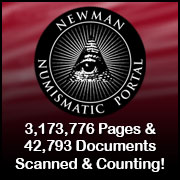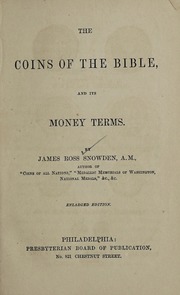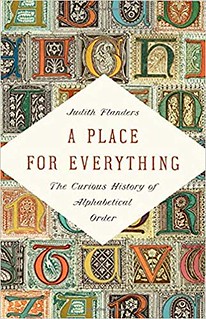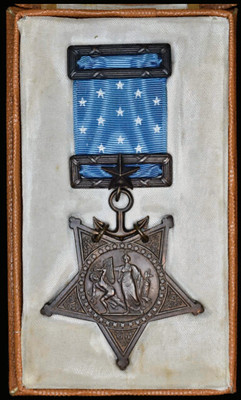
About UsThe Numismatic Bibliomania Society is a non-profit association devoted to the study and enjoyment of numismatic literature. For more information please see our web site at coinbooks.org SubscriptionsThose wishing to become new E-Sylum subscribers (or wishing to Unsubscribe) can go to the following web page link MembershipThere is a membership application available on the web site Membership Application To join, print the application and return it with your check to the address printed on the application. Print/Digital membership is $40 to addresses in the U.S., and $60 elsewhere. A digital-only membership is available for $25. For those without web access, write to: Charles Heck, Treasurer AsylumFor Asylum mailing address changes and other membership questions, contact Chuck at this email address: treasurer@coinbooks.org SubmissionsTo submit items for publication in The E-Sylum, write to the Editor at this address: whomren@gmail.com
BUY THE BOOK BEFORE THE COIN |
- WAYNE'S WORDS: THE E-SYLUM NOVEMBER 22, 2020
- CHARLES DAVIS DECEMBER 2020 SALE HIGHLIGHTS
- KENNY SAMMUT NUMISMATIC LITERATURE SALE
- NEW BOOK: THE FIRST COINS OF THE AMERICAS
- VLADIMIR AVANESYAN-FARID (C1934-2020)
- MORE ON BOWERS & MERENA'S THE COIN COLLECTOR
- VIDEOS: CLYDE HUBBARD INTERVIEWS
- ANOTHER CALDWELL LORD'S PRAYER CIVIL WAR TOKEN
- MORE ON THE G. ERICHSON COUNTERSTAMP
- NOTES FROM E-SYLUM READERS: NOVEMBER 22, 2020
- DIGITAL PHOTOGRAPHY: A NUMISMATIC GAME-CHANGER
- STACK'S BOWERS GALLERIES ACQUIRES COINS IN MOTION
- VOCABULARY TERM: SERIAL NUMBERING
- HEINRICH "HENRY" T. AHLBORN (1830-1907)
- HARVEY STACK'S NUMISMATIC FAMILY, PART 83
- ARTICLE PROFILES MINT ARTIST ARTIST ELANA HAGLER
- PAN'S COVID-19 COMPLIANT FALL 2020 SHOW
- COLTRANE 1776 NORTH CAROLINA HALIFAX NOTE SET
- NUMISMATIC NUGGETS: NOVEMBER 22, 2020
- POLITICS OF ANCIENT NUMISMATICS
- A NEW STUDY ON THE ORIGINS OF COINAGE
- A NEW STUDY ON ANCIENT COUNTERFEITING
- ROBERT I. NESMITH'S TREASURE HUNTER BROTHERHOOD
- 1813 NEW SOUTH WALES 15 PENCE 'DUMP'
- COLLECTOR OUTRAGE OVER THE U.S. MINT
- U.S. NAVAL MEDAL OF HONOR AUCTIONED
- AUSTRALIAN SOLDIER COULD LOSE VICTORIA CROSS
- MEXICO ISSUES NEW 100-PESO BANKNOTE
- IRAN'S NEW BANKNOTE WITH LIGHT-COLOR ZEROES
- THE EYE OF PROVIDENCE
- SPENDING THE SPACE FORCE $2 BILL
- TRAVANCORE SOUVENIR TABLEWARE MADE FROM COINS
- LOOSE CHANGE: NOVEMBER 22, 2020
- STIR-UP THREEPENNY PIECES
- FEATURED WEB SITE: MR. PEPYS' SMALL CHANGE
Content presented in The E-Sylum is not necessarily researched or independently fact-checked, and views expressed do not necessarily represent those of the Numismatic Bibliomania Society.
WAYNE'S WORDS: THE E-SYLUM NOVEMBER 22, 2020
 New subscribers this week include:
Sherwood A Clay.
Welcome aboard! We now have 6,594 subscribers.
New subscribers this week include:
Sherwood A Clay.
Welcome aboard! We now have 6,594 subscribers.
Thank you for reading The E-Sylum. If you enjoy it, please send me the email addresses of friends you think may enjoy it as well and I'll send them a subscription. Contact me at whomren@gmail.com anytime regarding your subscription, or questions, comments or suggestions about our content.
This week we open with two numismatic literature sales, a new book, updates from the Newman Numismatic Portal, and more.
Other topics this week include Clyde Hubbard, Henry Ahlborn, Robert Nesmith, Raymond J. Wayman, numismatic photography, the fall PAN show, North Carolina Halifax notes, the politics of ancient numismatics, the origins of coinage, collector outrage over the U.S. Mint, a U.S. Navy Medal of Honor, new world banknotes, Travencore tableware made from coins, and spending the Space Force $2 bill.
To learn more about Ted Natfzger's Large Cents, Hungarian tokens, the first coins of the Americas, Caldwell's Lord's Prayer token, Snowden's Coins of the Bible, Apollo 11 medals, upgrading coin photos, serial numbering, alphabet tokens, ancient counterfeiting, Pirate coins, the Eye of Providence and numismatic nurse Ratched, read on. Have a great week, everyone!
Wayne Homren
Editor, The E-Sylum
CHARLES DAVIS DECEMBER 2020 SALE HIGHLIGHTS
Charlie Davis submitted this note with more highlights of his upcoming numismatic literature sale. Beautiful material. -Editor
Our December 5 auction catalogue and current 1350 lot fixed price list of North American and British numismatic works should be in the hands of subscribers - despite the mail slow-down caused by the pandemic. Those who have not received them may visit the on-line versions at Numisbook.com. The auction offers unique works from the libraries of Dave Bowers, Howard Newcomb and Ted Natfzger, with all lots illustrated on our alternate site charlesdavisnumismatics.com. Highlights include:
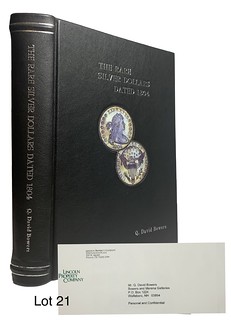
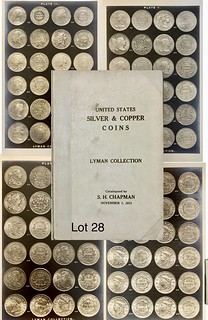
Lot 21: Presented by Brent Pogue to Dave Bowers
Lot 28: S. H. Chapman's Plated Lyman Catalogue
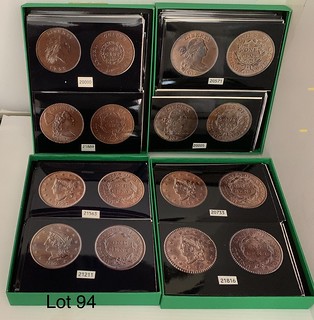
Lot 94: Noyes Photos of Ted Natfzger's Large Cents
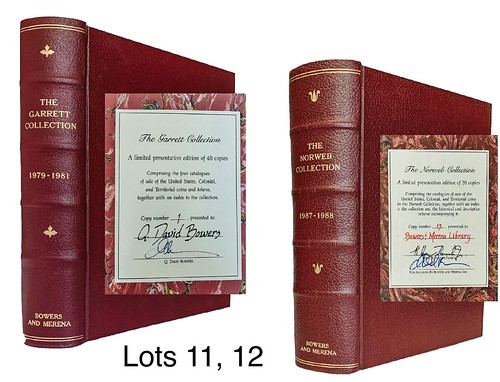
Lots 11, 12: Dave Bowers personal copies of the presentation Garrett and Norweb Catalogues
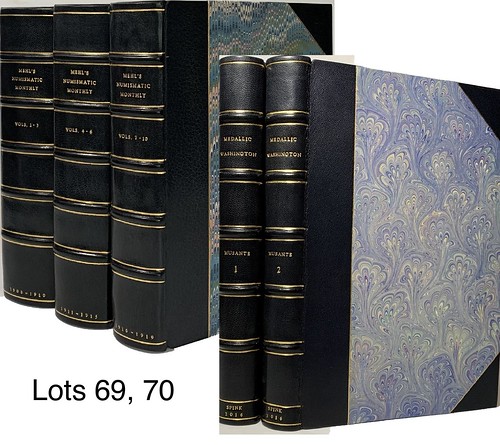
Lots 69, 70: Mehl Monthly and Medallic Washington in Harcourt bindings
To read the earlier E-Sylum article, see:
CHARLES DAVIS DECEMBER 2020 SALE SELECTIONS
(https://www.coinbooks.org/v23/esylum_v23n42a03.html)

KENNY SAMMUT NUMISMATIC LITERATURE SALE
Kenny Sammut writes:
"As we head into the holiday season, I am offering 40% off on all 400+ numismatic books/literature listings on my eBay store. Whether the books are a gift for your favorite numismatist or yourself, I know they will be enjoyed!
"While you are visiting my store, please take a look at the thousands of coin, bullion, and exonumia listings.
"I just purchased a 3000 plus token collection and will be creating listings over the next several weeks so if you are a tokens collector, I invite you to take a look."
There's still a nice selection of books available, and at great prices. Here are screenshots of some of the offerings. Check it out. -Editor
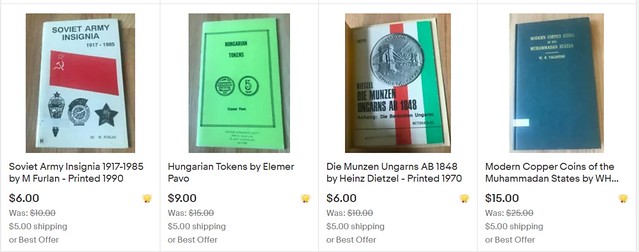
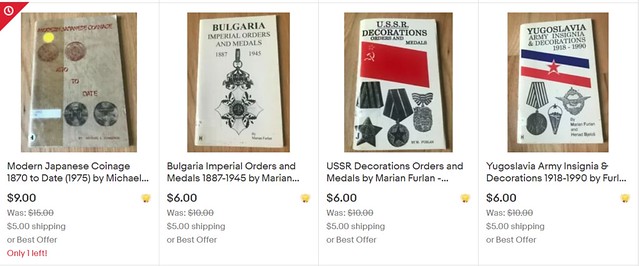
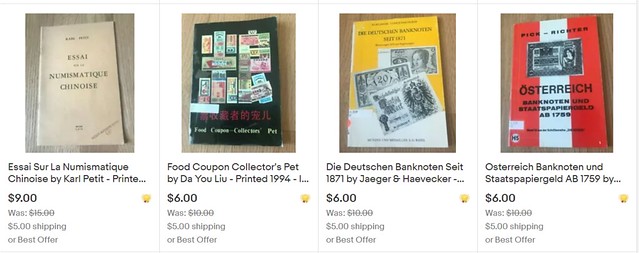
To visit Kenny's eBay store, see:
https://www.ebay.com/str/numismaticswithkenny/Numismatic-Books-Literature/_i.html?_storecat=29010782014

NEW BOOK: THE FIRST COINS OF THE AMERICAS
Peter Jones has authored a new book on Spanish colonial cob coinage. Here's the announcement. -Editor
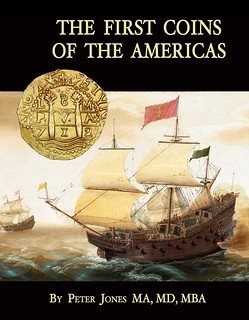 The First Coins of the Americas describes the author's personal journey with Spanish colonial coins
called cobs. The first mint of the Americas opened in Mexico City in 1536. A lifelong collector, Jones explores the
background of the conquistadors and the Spanish colonial system, then gives the fascinating stories behind each coin
with up to date scholarship on current thoughts about each series.
The First Coins of the Americas describes the author's personal journey with Spanish colonial coins
called cobs. The first mint of the Americas opened in Mexico City in 1536. A lifelong collector, Jones explores the
background of the conquistadors and the Spanish colonial system, then gives the fascinating stories behind each coin
with up to date scholarship on current thoughts about each series.
The book is profusely illustrated with color photos, and includes full page pictures of 129 coins. The book is 8.5 by 11 inches, hard back with 250 pages. Foreword by Daniel Sedwick. Sections include: Spanish coinage before the New World; Mexican money before the first mint of 1536; Carlos and Juana Early and Late series precobs coinage; Santo Domingo and Lima precobs; A type collection of silver and gold cobs by mint: Mexico City, Lima, La Plata, Potosí, Panama, Bogotá, Cartagena, Cuzco and Guatemala.
Extensive references are given throughout. The book finishes with thoughts about cobs and treasure coins. This includes why they made cobs, cobs as collectibles, mint expenses, the mining process at Potosí, the fleet system of galleons and naos used by the Spanish, and the New World class systems. Following this is a history of treasure salvage and diving techniques, and a list of 22 important shipwrecks yielding cobs. An 11-page glossary lists all the assayers and dates of each colonial mint, Spanish monarchs and their details including the famous Habsburg jaw, listings of the mints, colonial administrators, viceroyalties, audiencias, matronymic naming, styles of cobs, metrology and complete index. If you have any interest in Spanish colonial history, Spanish colonial coins (cobs), or numismatics in general, this reference book is eminently readable and a must for your collection.
Daniel Sedwick writes the following Foreword:
This book is pure inspiration. Whether you are a seasoned collector or a nascent novice, you will finish this book with a sense of purpose and justification for the hours you spend pursuing coins for no other reason than you just want them. In these pages, Peter Jones demonstrates his personal journey of collecting the first coins (and pre-coins) of the Americas by relating the history behind each type and period and location.
At every turn he makes sure to share his own angle and personal interest—and then he shows you each coin in the highest resolution possible, warts and all, so you can see for yourself what attracted him. As Peter points out, his goal was not completeness—as admittedly many coins were outside his range of attainability—so much as representation. The picture that emerges is that of a longtime collector fully sated with a sense of accomplishment and eager to share his joyful journey with the next generation.
There have been other books like this, such as like Thomas Sebring's Treasure Tales (1986) and James Bevill's The Paper Republic (2009), which were written by collectors and for collectors to relate the myriad of mind-excursions each collector takes with every acquisition, as opposed to giving the final word on every topic. One who buys coins for their value alone, without feeling the nagging curiosity of where each coin has been and what history it witnessed, is just an accumulator, whereas a collector truly loves each of his conquests and cannot stop until he or she understands its backstories.
The ultimate in learning about your collection, as Peter shows us here, is to write about it. Along the way he provides many tables and maps in addition to the beautiful coin photos. As a final note, I would like to say that in the thirty-odd years I have known Peter, he has always exemplified the Gentleman Collector, eager to learn and purchase within his means while enjoying friendship and camaraderie with his fellow numismatists. I am honored to call him my friend.
About The Author
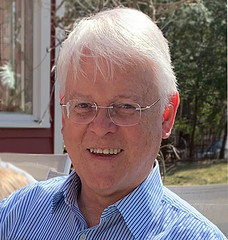 Passionate collector, Dr. Peter Jones describes his fascination with Spanish American colonial coins. The very first
coins were struck in the Americas in 1536, You can actually feel the connection to the past when you hold these
coins in your hand. Perhaps a conquistador once held the same coin! This book tells the stories behind these coins.
Passionate collector, Dr. Peter Jones describes his fascination with Spanish American colonial coins. The very first
coins were struck in the Americas in 1536, You can actually feel the connection to the past when you hold these
coins in your hand. Perhaps a conquistador once held the same coin! This book tells the stories behind these coins.
Peter trained at Cambridge and Oxford Universities, UK, doing a dual residency in Family Practice and Internal Medicine. In 1977 he immigrated with his wife, Ann, and their three daughters to rural Connecticut, where he practiced Internal Medicine for 39 years. His avocations have included classical piano, flamenco and classical guitar, American financial history, magic, and numismatics. He has also authored Notable Notes, Dow Jones by Peter Jones, Commemorative Coin Tales, The First Medals of America, Colonial History in Your Hands, and with Cynthia Adams, Therapeutic Communication, now in its third edition.
The book contains the most up to date listing of all the Spanish colonial American mint assayers and their dates.
Dan Sedwick has a limited number of copies available for $60 postpaid.
The book is advertised on pages 100 and 132 of his Treasure Auction 28 catalog. For more information or to order, email:
sedwickcoins@gmail.com
The book can also be purchased beginning January 1, 2021 for $79 plus $4.99 postage from:
https://store.bookbaby.com/book/the-first-coins-of-the-americas
-Editor
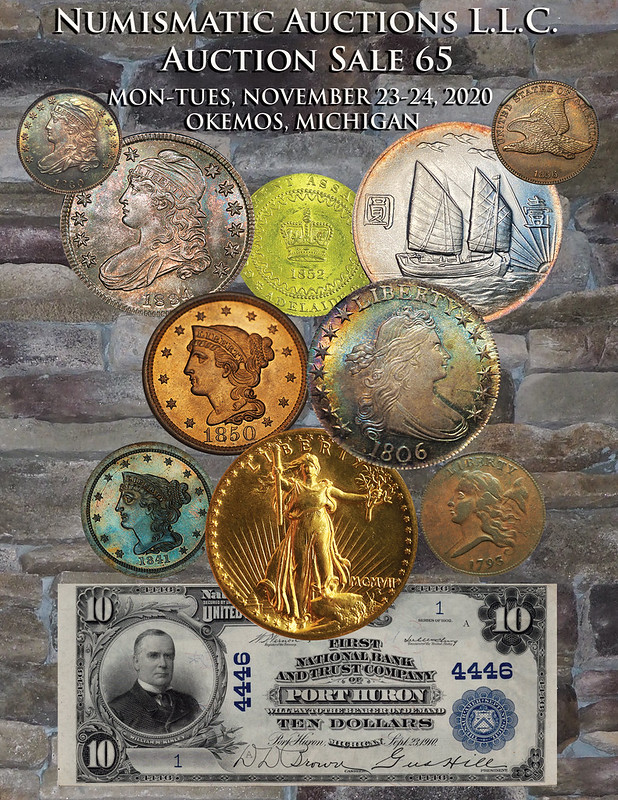
VLADIMIR AVANESYAN-FARID (C1934-2020)
Iranian-Armenian numismatist Avanesyan-Farid has passed. -Editor
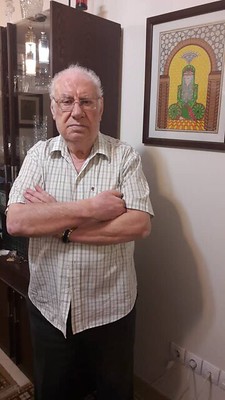 Vladimir Avanesyan-Farid, a distinguished Iranian numismatist of Armenian origin died in Tehran's Firuzgar Hospital on Friday. He was 86.
Vladimir Avanesyan-Farid, a distinguished Iranian numismatist of Armenian origin died in Tehran's Firuzgar Hospital on Friday. He was 86.
The coin and medals collector passed away due to old age, ISNA quoted his friend and colleague Amir-Hossein Moeini as saying.
Also known as Edik, he moved to Tabriz in 1938 with his family and started working in a goldsmith shop while he was seven or eight years old, he said.
"Working in this shop was his first encounter with coins and gold, prompting him to collect antique coins, which were no longer being minted, while he was also interested in collecting matches, stamps, banknotes, and medals."
Iranian scholar Ali Shahidi also said that Avanesyan-Farid was very proficient in numismatics, especially in the field of joint cultural heritage of Iran and Armenia.
"Although he had not studied academically, he was also an expert on the history of Iranian and Armenian banknotes and stamps," Shahidi added.
To read the complete article, see:
Iranian-Armenian numismatist Avanesyan-Farid dies at 86
(https://www.tehrantimes.com/news/454900/Iranian-Armenian-numismatist-Avanesyan-Farid-dies-at-86)

MORE ON BOWERS & MERENA'S THE COIN COLLECTOR
Newman Numismatic Portal Project Coordinator Len Augsburger provided this update to last week's report. Thanks. -Editor
More on Bowers & Merena's The Coin Collector
David Lange sent a comment regarding Bowers and Merena's Coin Collector, which was mentioned in the last issue of The E-Sylum. David writes "I'm looking forward to spending some time with The Coin Collector. I received all issues when new, but a tabloid newsletter was not the sort of thing I'd save. One issue has a photo of my cat Frasier guarding my collection of Bowers & Ruddy / Bowers & Merena catalogs. Can you find it?" Indeed we can, this was published in the Coin Collector issue of October 7, 1996. Q. David Bowers wrote in the caption
"David W. Lange sent us this picture of his ‘fearless cat Frasier ever at the ready to defend my collection of your company's catalogues against intruders.' Grateful, we have sent Frasier a can of cat food with our compliments."
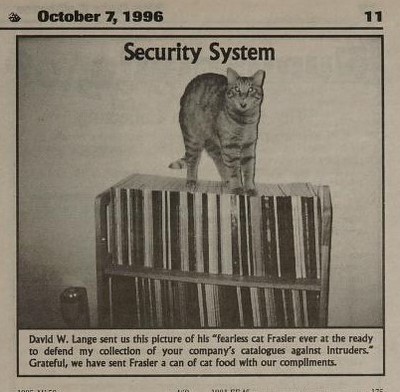
David Lange adds today "There he is---my favorite cat of all time. He loved to nap atop those catalogs. It may have had more to do with their being under the heat vent than with any numismatic inclination on his part."
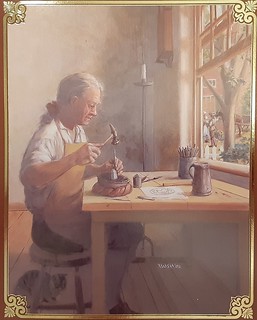 We can not say for sure, but one of the catalogs on the shelf might have been the fixed price list of 1794 large cents, from the John W. Adams collection, sold by Bowers & Ruddy in 1982. The cat depicted on the cover of this catalog was an homage to Adams, a noted feline aficionado.
We can not say for sure, but one of the catalogs on the shelf might have been the fixed price list of 1794 large cents, from the John W. Adams collection, sold by Bowers & Ruddy in 1982. The cat depicted on the cover of this catalog was an homage to Adams, a noted feline aficionado.
Image: David Lange's cat Frasier, from The Coin Collector #41
Image: Cover illustration from the John W. Adams 1794 large cent fixed price list
David adds:
"The Adams large cent catalog was indeed among my B&R/B&M catalogs, which were complete from 1972 onward. I also owned a copy of the deluxe edition, #79 I believe.
"I'm attaching the original photo, as Frasier's charming ginger needs to be seen in color to really appreciate it."
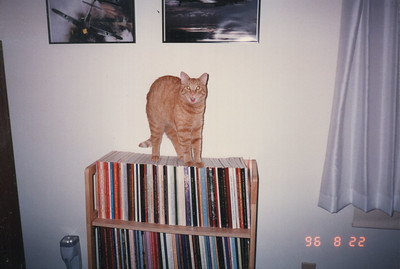
Link to The Coin Collector on Newman Portal:
https://nnp.wustl.edu/library/publisherdetail/539529
Link to The Celebrated John W. Adams Collection of United States Large Cents of the Year 1794:
https://nnp.wustl.edu/library/book/578290
To read the earlier E-Sylum article, see:
BOWERS & MERENA'S THE COIN COLLECTOR ON NNP
(https://www.coinbooks.org/v23/esylum_v23n46a06.html)
VIDEOS: CLYDE HUBBARD INTERVIEWS
These are selections from the David Lisot Video Library that feature news and personalities from the world of coin collecting. David has been attending coin conventions since 1972 and began videotaping in 1985. The Newman Numismatic Portal now lists all David's videos on their website at:
https://nnp.wustl.edu/library/multimediadetail/522852
Here are two videos with the late Clyde Hubbard. -Editor
Numismatic Personality: Clyde Hubbard, March 26, 2010
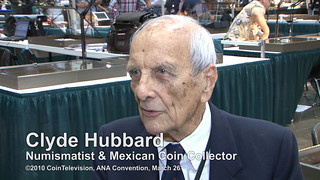 Clyde Hubbard, David Lisot of CoinTelevision com. David talks with Clyde Hubbard and James P Bevill, Gene Hinds, Pat Hyads, Mark Lighterman, J R Rollo, and Tony Tumonis at the American Numismatic Association Convention in Fort Worth Texas. Clyde talks with some of his friends including Grover Criswell Bob Hendershot and much more. Clyde is one of the great numismatists.
Clyde Hubbard, David Lisot of CoinTelevision com. David talks with Clyde Hubbard and James P Bevill, Gene Hinds, Pat Hyads, Mark Lighterman, J R Rollo, and Tony Tumonis at the American Numismatic Association Convention in Fort Worth Texas. Clyde talks with some of his friends including Grover Criswell Bob Hendershot and much more. Clyde is one of the great numismatists.
Numismatic Personality: Clyde Hubbard, March 26, 2010 (https://nnp.wustl.edu/library/book/578803)
Numismatic Personality: Clyde Hubbard, November 3, 2012
Clyde Hubbard, Interviewers Cory Frampton Max Keech. Two principal players from the Mexican Coin Company interview longtime Mexican and Latin American coin collector Clyde Hubbard.
Numismatic Personality: Clyde Hubbard, November 3, 2012 (https://nnp.wustl.edu/library/book/560415)

ANOTHER CALDWELL LORD'S PRAYER CIVIL WAR TOKEN
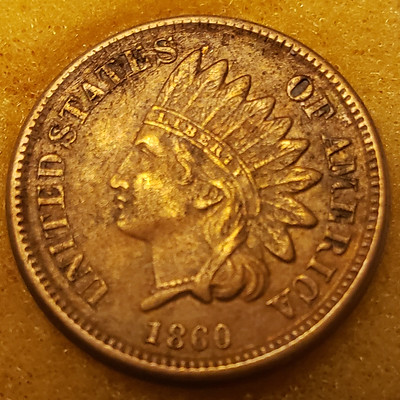
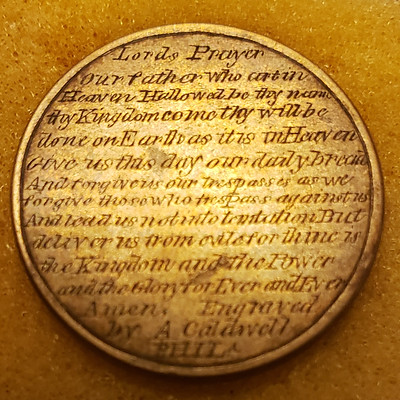
Jesse Strange's example
Website visitor Jesse Strange writes:
"Over the years I have occasionally searched for information about a man named A. Caldwell, but never found anything. I always assumed that he was part of the J.E. Caldwell Jewelry family of Philadelphia. While searching under "Lord's Prayer Coin" recently I came across an article, written by Bill Groom, that was published in the Summer 2020 issue of the Civil War Token Society Journal. The point of this communication is that I also have one of the Indian Head coins with the Lord's Prayer on the back of it. It is dated 1860 and signed A. Caldwell. It belonged to my Grandfather. If the coin was new, as it appears to be, when it was produced it would pre date the civil war. I have had this coin for many years. Is there any value to this coin or is it more or less just a keepsake?"
I put Jesse in touch with Bill Groom. -Editor
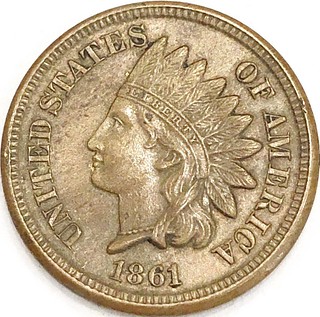
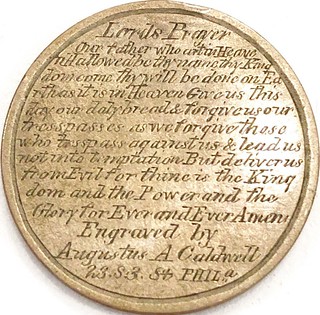
Bill Groom's example
Bill Groom writes:
"After seeing Jesse's 1860 dated Caldwell prayer cent, I'm now gonna be on the lookout for other dates: 1859, 1862 .... While it's logical to suspect that Caldwell created this cent in 1860, it could have been made in 1861 or a few years later. That said the absent address makes it virtually impossible to nail down its creation.
My answer to Jesse's question is .... "Sure, it's an artful keepsake, being of better than average value to exonumia collectors." We know who engraved the coin, where he did so and about when he did it. If only we knew more about Caldwell. Might these Lord's Prayer tokens have been given as parting gifts to Civil War soldiers and tucked in safe places? Perhaps, somewhere, something has been written that will provide more info than we now have. Still, in addition to a cool coin, I do love a good mystery!"
Jesse adds:
"Grandfather was a Chiropodist (Podiatrist) and during the Depression he received a variety of items as payment. Chickens, eggs, fruits and veggies. I can only guess that this may have been given in payment for his service during that time. He did have an office in center city Philadelphia. Who knows, A Caldwell family member may have been a patient."
Thanks. Interesting mystery. -Editor
To read the earlier E-Sylum article, see:
THE CALDWELL LORD'S PRAYER CIVIL WAR TOKEN
(https://www.coinbooks.org/v23/esylum_v23n26a23.html)
MORE ON THE G. ERICHSON COUNTERSTAMP
Bill Groom also provided this follow-up for readers on his article about the G. ERICHSON counterstamp. Thanks! -Editor
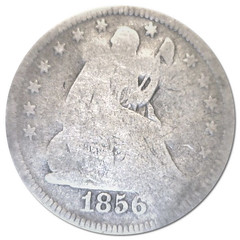
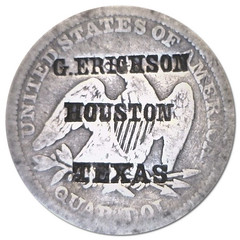
Over a year ago, now, I managed to acquire a long-sought Erichson counterstamp on an early quarter. In addition to the G. ERICHSON name stamp, it reportedly boasted both HOUSTON and TEX stamps. Might this 1856 be the storied quarter, mentioned in the 1895 newspaper article?
The New Orleans author of the letter to Erichson wrote about his quarter being stamped, "G. Erichson, Houston, Tex." Might he simply have abbreviated "TEXAS" as stamped on this 1856 quarter? Or, did Erichson also utilize an abbreviated version of Texas?
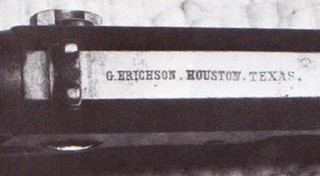 So far, this writer has only seen Gustave Erichson firearms bearing unabbreviated TEXAS stampings; these, including revolvers, a shotgun and rifles. One of Gustave's sons, Otto, stamped a gun in italics, utilizing "TEX." Given that no "TEX" stampings are yet apparent on any of Gustave's firearms, it stands to reason that this abbreviated stamp is unlikely to be found on Erichson's coins. Still, I'm not willing to exclude that possibility, so the hunt continues!
So far, this writer has only seen Gustave Erichson firearms bearing unabbreviated TEXAS stampings; these, including revolvers, a shotgun and rifles. One of Gustave's sons, Otto, stamped a gun in italics, utilizing "TEX." Given that no "TEX" stampings are yet apparent on any of Gustave's firearms, it stands to reason that this abbreviated stamp is unlikely to be found on Erichson's coins. Still, I'm not willing to exclude that possibility, so the hunt continues!
To read the earlier E-Sylum article, see:
THE G. ERICHSON COUNTERSTAMP
(https://www.coinbooks.org/v20/esylum_v20n18a26.html)

NOTES FROM E-SYLUM READERS: NOVEMBER 22, 2020
Wu Zhu Graffiti Compilation Available
Ted Puls writes:
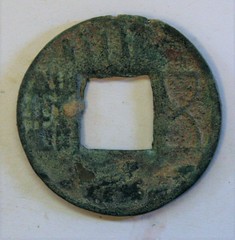 "This short writing is my attempt to organize the marks found on ancient Chinese coins called wu zhu or "five grain" bronzes. The eleven-page text comprises a description of the marks; a chart of the marks that I have found, with a code to allow shorthand notation of each mark. A description of how to use the coding system follows. A brief description of the spreadsheet design precedes the spreadsheet. The spreadsheet contains my attempt to organize the myriad combinations of marks on varied wu zhu in a 15 column by about 1100 line format. I would be willing to email this to ones with interest in the area."
"This short writing is my attempt to organize the marks found on ancient Chinese coins called wu zhu or "five grain" bronzes. The eleven-page text comprises a description of the marks; a chart of the marks that I have found, with a code to allow shorthand notation of each mark. A description of how to use the coding system follows. A brief description of the spreadsheet design precedes the spreadsheet. The spreadsheet contains my attempt to organize the myriad combinations of marks on varied wu zhu in a 15 column by about 1100 line format. I would be willing to email this to ones with interest in the area."
Ted can be reached at tedkate@comcast.net. -Editor
To read the earlier E-Sylum article, see:
CHINESE WU ZHU COIN VARIETIES SYSTEM OFFERED
(https://www.coinbooks.org/v23/esylum_v23n18a08.html)
Snowden's 1864 The Coins of the Bible
I enjoyed David Gladfelter's article in the latest Asylum: The Second American Book on Ancients. I wrote to him this week, noting that he missed one other early American book on ancients - Snowden's 1864 The Coins of the Bible, and its Money Terms. -Editor
David writes:
"That one got by me, dammit. Should have posted an inquiry on The E-Sylum – at least you would have caught it. Please run a "correction" ASAP, you may tease out even more earlier ones. It's to be expected.
"Michael Sullivan did a really thorough job of researching and publishing his annotated bibliography of bank histories from 1878 to 2000. Not knowing that he was working on it I didn't tell him of one from 1865 that I had. His reaction was probably the same as mine but he was too gracious to say so."
My copy of Snowden's book (and the one on the Newman Numismatic Portal) is the "Enlarged Edition" (but I've never seen another kind). Is anyone aware of a different edition? It's a rare work, a compilation of Snowden's Sunday School lectures, where the former Mint Director worked coins into his lessons.
And is anyone aware of other early American books on ancient coins? -Editor
To read the book on NNP, see:
The coins of the Bible, and its money terms
(https://nnp.wustl.edu/library/book/588338)
Roper Roundup
Bryce Brown writes:
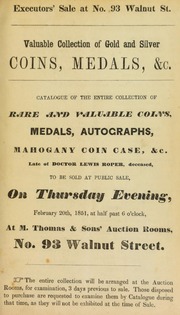 "I have immersed myself in a research project pertaining to the Dr. Lewis Roper auction sale of February 20-21, 1851, held by M. Thomas & Sons, in Philadelphia. Thanks to the outstanding research of others, there is already a great deal known about the sale and auction catalog. I believe there is more to be discovered and shared with the numismatic literature community. I am hereby reaching out to owners of any type of Lewis Roper sale catalog, with the hope of filling in some data gaps, as well as collaboratively resolving some contradictory information I have found. Please contact me at:
numismatics@att.net Thank you! "
"I have immersed myself in a research project pertaining to the Dr. Lewis Roper auction sale of February 20-21, 1851, held by M. Thomas & Sons, in Philadelphia. Thanks to the outstanding research of others, there is already a great deal known about the sale and auction catalog. I believe there is more to be discovered and shared with the numismatic literature community. I am hereby reaching out to owners of any type of Lewis Roper sale catalog, with the hope of filling in some data gaps, as well as collaboratively resolving some contradictory information I have found. Please contact me at:
numismatics@att.net Thank you! "
Great project! I've provided Bryce with information on my copy. Please help out if you can. -Editor
To read the catalog the Newman Numismatic Portal, see:
Valuable collection of gold and silver coins, medals, &c. : catalogue of the entire collection of rare and valuable coins, medals, autographs, mahogany coin case, &c., late of Doctor Lewis Roper, deceased ... [02/20/1851]
(https://nnp.wustl.edu/library/auctionlots?AucCoId=511814&AuctionId=515595)
San Francisco International Bourse Coin Show Cancelled
Scott Griffin writes:
"Due to the recent tightening of in-person meetings related to Covid-19, the San Francisco International Bourse Coin Show that was scheduled for December 5th, 2020 at the SSF Conference Center has been Cancelled.
"If you know of someone coming to the Show, please reach out to them if possible to let them know.
"Although I'm deeply disappointed about this development, I remain committed to spreading the word of our wonderful hobby and creating spaces for individuals to enjoy this hobby.
"In the coming weeks, I'll be working with my partners to establish a time in Spring 2021 when we can have this special event."
Thanks to David Lisot for passing along Scott's announcement. -Editor
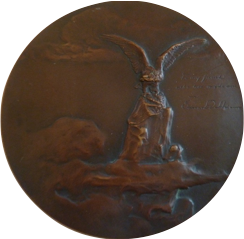 Bronze Plaque Inscribed to Edward D. Adams
Bronze Plaque Inscribed to Edward D. Adams
Scott Miller writes:
"I thought I might add the following to the write-up on Edward Dean Adams.
"In addition to the medals mentioned, there is a 140mm, uniface, cast bronze plaque that I obtained from Bob Myers many years ago. It depicts an eagle on top of a rocky crag, surrounded by clouds, and the inscription To my friend / who has made one / in / Edward D Adams. Unfortunately, the plaque is not signed. "
Thanks! -Editor
To read the earlier E-Sylum article, see:
EDWARD DEAN ADAMS (1846-1931)
(https://www.coinbooks.org/v23/esylum_v23n46a16.html)
Medals by Michael Gaspard Rizzello
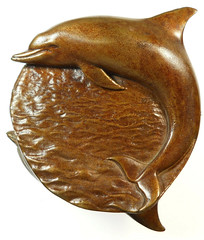
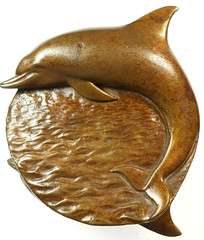
Eric Holcomb writes:
"Thanks for showing the wonderful Dolphin Medal by Rizzello.
"This is almost certainly by Michael Gaspard Rizzello (1926-2004), who was a sculptor and designer, born in London of Italian parents. He designed coins and medals in addition to public statues and other works. [Ref.: Wikipedia]
"An image of his Apollo 11 medal is attached. (Data: 44.5 mm (1.75 inches), bronze, 44 grams.) This is one of the 50 Apollo 11 medals I displayed in my exhibit at the 2019 ANA convention in Chicago/Rosemont.
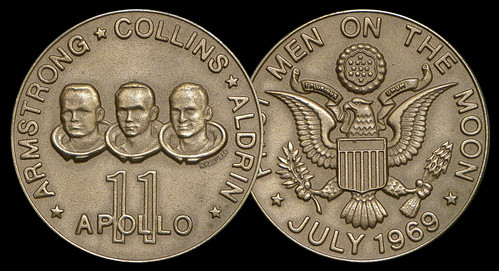
Eric adds:
"Curiously, there is also a small (35 mm) Apollo 11 souvenir medal issued by the Rizzoli Bookstore on Fifth Avenue in New York City, which depicts an open book on the reverse! I'm also attaching an image of that medal. The medal is signed by Gregorio Sciltian (1900–1985), an Italian-Armenian artist and medallist. "
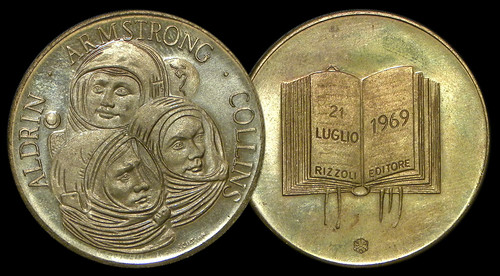
Thanks! I had reached out to the dolphin medal's seller, Hedley Betts, asking "Those are obverse and reverse photos, correct?" -Editor
Hedley writes:
"You are correct - the obverse and reverse are virtually identical. I have since sold it to an overseas buyer."
To read the earlier E-Sylum article, see:
NUMISMATIC NUGGETS: NOVEMBER 15, 2020 : Dolphin Medal by Rizzello
(https://www.coinbooks.org/v23/esylum_v23n46a21.html)
Hamilton's 15th Sale Lot Information Sought
Michael Niebruegge writes:
"I am looking for information about lot 42 in Charles Hamilton's 15th Sale on November 3, 1966. It apparently describes the lot as the Property of Lucius Ruder, but I do not know what book it actually was. In any event, I am trying to run this down as I understand this might have been a lot actually consigned by John J. Ford, not Ruder, using one of Ford's tactics. I am trying to determine if that was a book that ended up in the Ford Book Sale. If one of your readers has any information on that lot or Sale, I would appreciate it."
Can anyone help? -Editor
More on The Good Old Days
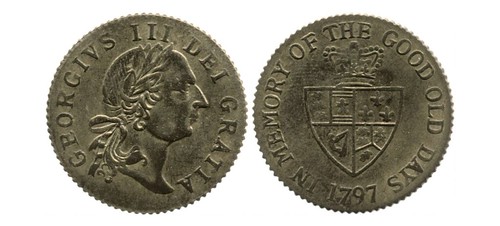
Martin Purdy writes:
"Further to the piece described in this week's E-Sylum (and also the recent Numismatist article), I don't think the original article made it very clear that the dates on these items aren't genuine, and that many purporting to have been issued under George III's reign (died 1820) were made as late as the 1930s! Even those with obviously fictitious dates like 1701 (the king wasn't born till 1738) were almost certainly made in the Victorian era or later. Most makers were based in Birmingham, England, as far as I know.
"So if there's any historical relevance to the "Good Old Days" as mentioned on the token, it was probably the maker harking back 80-100 years to the time of George III's reign, not looking back from 1797 to an even earlier time.
"By the way, the 1797 item illustrated was the first item I ever got of this kind, when I was about 10 years old, and it later became part of a small collection of different types of spurious guineas and half-guineas with various legends and effigies that I still find quite fascinating. I think this is probably the best quality design of the bunch."
Thanks. Interesting items. -Editor
To read the earlier E-Sylum article, see:
NOTES FROM E-SYLUM READERS: NOVEMBER 15, 2020 : The Good Old Days
(https://www.coinbooks.org/v23/esylum_v23n46a12.html)
On Coin Image Orientation
Ted Puls writes:
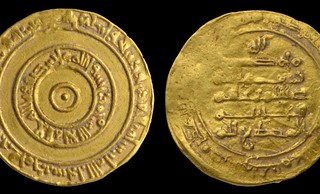 "I got a small chuckle out of the "Gold Dinar Found in Jerusalem's Old City". I frequently see Chinese coins pictured sideways or upside down. The Arabic coinage in this article was sideways in the side picture. I had always thought the error only applied to Chinese coins. I found a moment of enlightenment."
"I got a small chuckle out of the "Gold Dinar Found in Jerusalem's Old City". I frequently see Chinese coins pictured sideways or upside down. The Arabic coinage in this article was sideways in the side picture. I had always thought the error only applied to Chinese coins. I found a moment of enlightenment."
To read the earlier E-Sylum article, see:
GOLD COINS FOUND IN JERUSALEM'S OLD CITY
(https://www.coinbooks.org/v23/esylum_v23n46a22.html)
U.S. Proof Coin Paperweight-Lighter
David Luftig passed along this ad from a 1958 Esquire magazine. Thanks. Has anyone seen one of these? -Editor
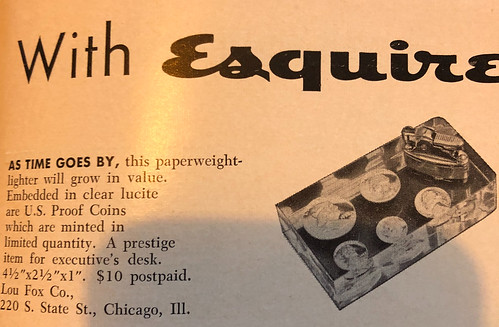
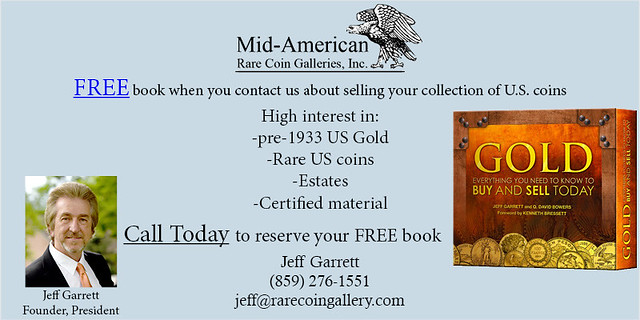
DIGITAL PHOTOGRAPHY: A NUMISMATIC GAME-CHANGER
Jeff Garrett published an NGC article on digital photography in numismatics. Here's an excerpt - be sure to read the complete article online. -Editor
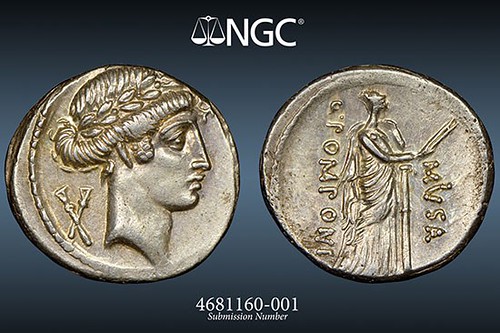
High-quality digital photography has become a game-changer in numismatics.
The world of rare coins has gone almost entirely online.
Who would have thought a few years ago that a major auction company could sell tens of millions of dollars in rare coins online? Traditionally, buyers would attend major conventions and view lots for several days before making purchases. That has all changed, and one of the key factors has been the advanced development of quality digital photographs. Buyers can now bid confidently based solely on images provided by online sellers.
The shift from film to digital photography
In 1984, I started a rare coin auction company and found that getting quality photography was quite the chore. We needed to build a dark room and hire someone to take the pictures. Our first auction catalog used images developed in a bathtub by my partner, Ron Guth. A few years later, Tom Mulvaney joined the company and has worked with me in various capacities ever since. His photography techniques and skills have evolved over the years, and today he is known as one of the best rare coin photographers in the world.
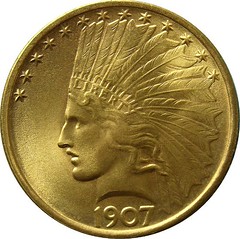
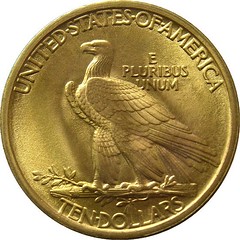
I called him about this article and asked when he started using digital photography. When he was a photographer for PCGS in 1995, management approached him about going digital. At the time, the price for a 1-megapixel camera exceeded $35,000. Going digital was sidelined for a few years, until 2000 when Tom bought a 2-megapixel camera for around $2,000. Today, a 20-megapixel camera typically costs under $300.
Many photographers, Tom included, resisted the use of digital photography for years because of quality issues. But now that the pixel count has grown, numismatic photography has gone entirely digital.
Today, digital photography is one of the key tools for the numismatics business. Quality digital images are necessary for anyone who lists a coin on eBay, has a website or produces catalogs. Those who are skillful enough to use software to enhance images are in high demand. Each day, thousands upon thousands of images of rare coins are posted online by rare coin sellers around the world. These range from shoddy phone pictures to impeccable studio images.
Online company sales are evidence of the market desirability for quality digital coin images. Many of these companies pride themselves on the standard of photos they use for their web businesses. I have even heard some of them say they consider how a coin will photograph before making a purchase.
A few rare coin companies outsource images for important coins to get the very best results. Recently, I overheard one of these sellers say that they send the coins to multiple photographers to find the best image possible. It's sort of like trying to get an upgrade on a coin photo!
To read the complete article, see:
Jeff Garrett: The Power of Pixels
(https://www.ngccoin.com/news/article/8705/)
STACK'S BOWERS GALLERIES ACQUIRES COINS IN MOTION
Numismatic imaging innovation continues apace. Here's a press release from Stack's Bowers announcing a new business acquisition. -Editor

Stack's Bowers Galleries ("SBG") is proud to announce the acquisition of Coins In Motion LLC. The patent-pending Coins In Motion technology creates high-resolution animations that accurately capture the in-hand visual appeal of coins and banknotes in a manner unlike any still or video photography available today. Coins In Motion animations will be first available for select highlights of the firm's December 2020 Showcase Auctions.
"Over the past several years we have seen technology's increasing and dramatic impact on the numismatic hobby," Stack's Bowers Galleries president Brian Kendrella remarked. "With the vast majority of sales now taking place strictly online from the comfort of our clients' homes or offices, we have worked hard to provide our customers with the information and tools that allow them to conveniently and confidently participate in our auctions. The inclusion of Coins In Motion ultra-high resolution animations supports this goal and enhances our award-winning static images by providing additional detail and replicating the experience of having the coin in hand."
The novel Coins in Motion technology will complement Stack's Bowers Galleries' extensive online tool kit that includes still photography, PCGS TrueView and NGC Photo Vision images, industry leading descriptions, and past auction prices realized, as well as leading third-party price guide information and PCGS, NGC, and CAC population guides.
Coins In Motion was created by Larry Stendebach who will be joining Stack's Bowers Galleries' unparalleled team. Mr. Stendebach is a numismatist and technologist with an extensive background in computer technology. He has collected for over 25 years, specializing in U.S. type and Spanish Colonial 8 Reales from Mexico.
If the above images aren't working for you, try these links:
Isabella Quarter
1924 Double Eagle
Cob
1942 Proof Half Dollar
To read related earlier E-Sylum articles, see:
COIN IMAGING FORMAT: NUTILT
(https://www.coinbooks.org/v23/esylum_v23n34a06.html)
MORE ON THE NUTILT COIN IMAGING FORMAT
(https://www.coinbooks.org/v23/esylum_v23n35a12.html)
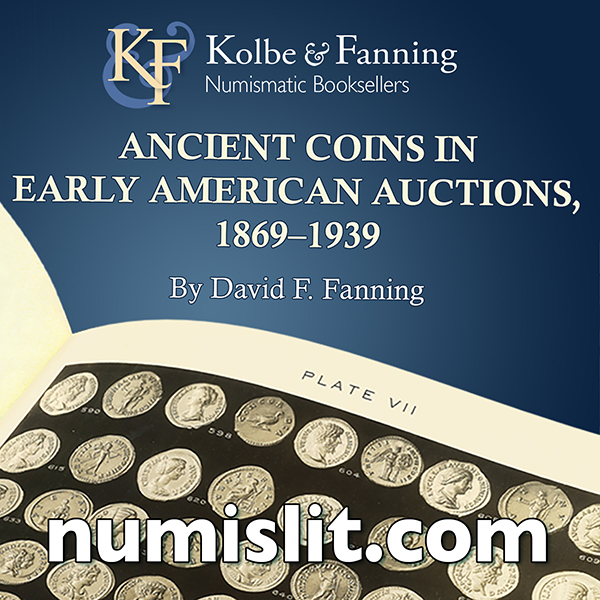
VOCABULARY TERM: SERIAL NUMBERING
Dick Johnson submitted this entry from his Encyclopedia of Coin and Medal Terminology. Thanks. -Editor
Serial Numbering. Consecutive numbering of medallic items in a limited issue to indicate that a quantity, not greater than that announced, has been issued. When all consecutive numbers in a series are not used (as 1–60, 65–70, 100-110 for example), this is known as interrupted numbering. Occasionally the year of issue, a trademark, other lettering or symbols appear with the serial number. If the piece is reeded and space is desired for numbering, the reeding may be eliminated in an area for the edge marking; such an area is called interrupted reeding. Serial numbers should be included with other edge lettering; as a number alone leads to confusion. For machine numbering the zeros are used ahead of the number; and 006 is confused with 900 as there is no orientation without other lettering. Numbering can be applied to the edge of a medallic item by hand (hand numbered), or by machine (numbering head). See edge lettering and numbering.
Looking for the meaning of a numismatic word, or the description of a term? Try the Newman Numismatic Portal's Numismatic Dictionary at: https://nnp.wustl.edu/library/dictionary
Or if you would like a printed copy of the complete Encyclopedia, it is available. There are 1,854 terms, on 678 pages, in The Encyclopedia of Coin and Medal Technology. Even running two a week would require more than 19 years to publish them all. If you would like an advance draft of this vital reference work it may be obtained from the author for your check of $50 sent postpaid. Dick Johnson, 139 Thompson Drive, Torrington, CT 06790.
HEINRICH "HENRY" T. AHLBORN (1830-1907)
John Lupia submitted the following information from the online draft of his book of numismatic biographies for this week's installment of his series. Thanks! As always, this is an excerpt with the full article and bibliography available online. This week's subject is Boston coin dealer Henry T. Ahlborn. -Editor
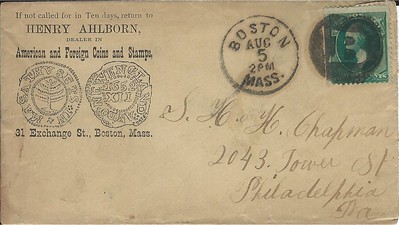 Ahlborn, Heinrich "Henry" T. (1830-1907), was born in Hanover, Germany on December 23, 1830, the son of Heinrich and Henrietta Ahlborn. He was a tailor and a cobbler. According to the 1900 U.S. Census and Attinelli in Numisgraphics he moved to America in 1850. Residence : Lawrence Street, Malden, Massachusetts. His Stationery, Books and Coin shop was first located at the Old Cambridge Toll House on West-Boston Bridge, and by 1878, he moved to 33 and then to 31 Exchange Street, Boston, Massachusetts.
Ahlborn, Heinrich "Henry" T. (1830-1907), was born in Hanover, Germany on December 23, 1830, the son of Heinrich and Henrietta Ahlborn. He was a tailor and a cobbler. According to the 1900 U.S. Census and Attinelli in Numisgraphics he moved to America in 1850. Residence : Lawrence Street, Malden, Massachusetts. His Stationery, Books and Coin shop was first located at the Old Cambridge Toll House on West-Boston Bridge, and by 1878, he moved to 33 and then to 31 Exchange Street, Boston, Massachusetts.
An immigrant tailor from Hannover, Germany he moved to Dedham, Massachusetts. On October 15, 1857 at Dedham, Massachusetts he married a native of Brunswick, Canada, Rebecca Flemming. For some odd reason he claimed at the time to be born 1834 though his wife was born 1838. In the 1900 U.S. Census it reads he was born in April 1832 and that Rebecca was born in December 1841. Moreover, Emmanuel Joseph Attinelli records his birth as April 1835. Apparently he preferred April over December for his birthday or else the death certificate gives the wrong age at the time of death. Though married 43 years in 1900 the Census reports they were married 36 years.
About 1860 he opened his shop at the Old Cambridge Toll House on West-Boston Bridge, Boston and later on turned coin dealer. One early purchase from Chadbourne around 1860 for $5.00 raised the ire of his wife, which was amended after he sold the coins for a profit. Mason calls him "Henry I" and Henry Cook as "Henry II". In 1865 he sold Parmelee $200.00 in coins. In December 1871 he was a bidder and a buyer at the Dr. Charles Clay sale held by W. Elliot Woodward at George A. Leavitt's auction house in New York. On January 29, 1875 his coin shop was robbed of $700 worth of coins. In November 1876 he won at a Cogan auction a VF 1794 silver dollar for $80. He eventually sold it to Major William Boerum Wetmore (q.v.).
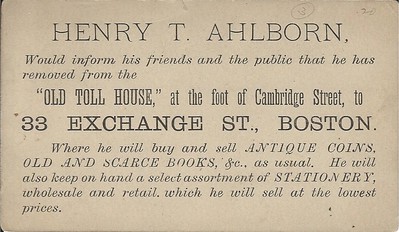
In September 1878 he moved his coin shop from the Old Cambridge Toll House on West-Boston Bridge to 33 Exchange Street, Boston, and advertised in Mason's Coin Collectors' Herald. In 1880, he changed the address to 31 Exchange Street, Boston and had business envelopes printed.
In 1880 he purchased the 1804 Silver Dollar from Phineas Adams, and soon sold it to John P. Lyman along with a set of silver dollars for $1,800. In May 1880 he became ill with typhoid fever. He conducted business with the Chapman brothers from 1880 to 1882. His collection was sold at auction by John W. Haseltine (52d sale) on June 16-17, 1881.
His Malden home was struck by lightning in 1884 on June 19. The lightning struck a tree uprooting it breaking the water main flooding his house. His wife fled to a neighbors home becoming ill needing a doctor. On one occasion the Chapman brothers broke an antique plate-glass while visiting his shop.
On March 18, 1889 while walking home in Malden, a railroad sign fell and struck him breaking his right shoulder blade at first it was thought he would recover. The newspaper the following day ran the news that his condition was serious and it was feared he would not recover. He died of bronchial asthma on November 29, 1907 twenty five days short of his 77th birthday according to his death certificate. He was buried in Saugus, Massachusetts.
Among his other famous coin sales is the 1796 half-dollar in about uncirculated condition he sold to Lorin G. Parmelee for $150.
To read the complete article, see:
AHLBORN, HENRY T.
(http://www.numismaticmall.com/numismaticmall-com/ahlborn-henry-t)
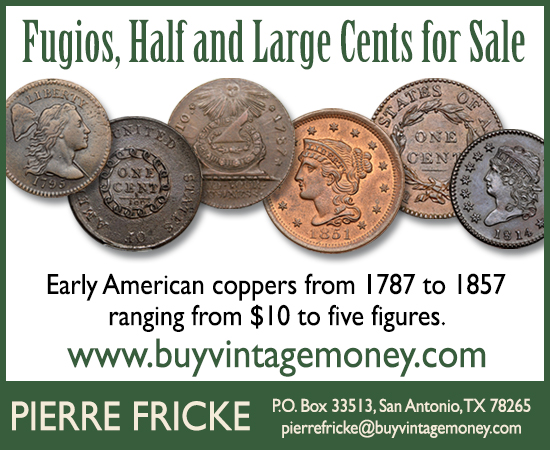
HARVEY STACK'S NUMISMATIC FAMILY, PART 83
The latest article in Harvey Stack's blog series continues with the year 1981: the Metropolitan New York Numismatic Convention sale, Auction '81, and the Raymond J. Wayman collection sale. Thanks, Harvey! -Editor
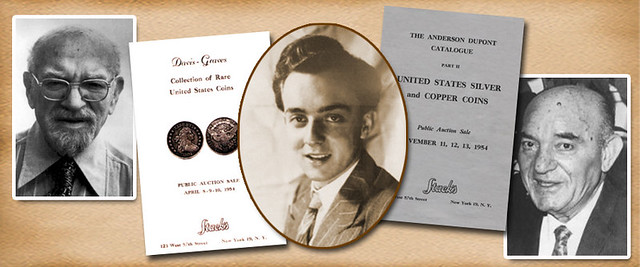
In 1981, public auction sales maintained some equilibrium on the market, and for Stack's the quantity and quality of the sales improved from January to December, indicating how the numismatic hobby was recovering after a tough start to the year.
In January we offered a comprehensive collection of United States gold, silver and copper, consisting of 986 lots with many of the popular early date and Proof items. The attendance was great, sometimes with standing room only, as the collectors vied for some bargains as each lot was sold. Our March auction contained a larger group of consignments, 1,395 lots of United States coins and paper money. We received quite a number of bid sheets and attendance was again good. Many were surprised that the market for Proof and choice Mint State coins was very active and the sale attracted reasonable bids. Confidence seemed to be growing in our bidders.
In May 1981 we once again presented an auction in conjunction with the Metropolitan New York Numismatic Convention, sponsored by nine local coin clubs from New York, New Jersey and Connecticut. This was considered to be the most important spring convention held in the Northeast. Stack's was able to assemble over 1,350 lots for this important sale, including 639 lots of foreign and ancient coins. Contained in the United States portion of the sale were full sets of Shield and Liberty nickels, plus a super set of two-cent pieces and a selection of coins that spanned from the colonial era through the mid 20th century. A wonderful offering of U.S. gold included four different $50 slugs. Bidding was active and, in fact, for the U.S. portion we had to move to a larger room, as the regular ballroom was unable to accommodate the collectors and viewers. I remember being the auctioneer at this sale, and felt that I had to keep very alert and work hard to keep up with the activity. The convention dinner that night was oversold and everyone really enjoyed the event.
For our June sale, Stack's was able to assemble some 921 lots of United States coins, highlighted by a nice selection of colonial coinage, early U.S. gold that started with $5 and $10 pieces from 1795, plus a goodly number of scarcer dates.
After having two successful years with the "Apostrophe Auctions" we once again offered a joint public auction in July 1981 with Rarcoa, Paramount, and Superior. As before each company was to offer 500 lots, so the total sale would feature 2,000 lots. In this year, Stack's was fortunate to have consignments that would have exceeded the 500 lot limit. We decided, along with the consignors, that we could take some of the outstanding sets that had been consigned and sell them as sets. We offered the following as sets: two-cent pieces, three-cent silver pieces, Shield nickels, Liberty Head nickels, Buffalo nickels, Mercury dimes, 20-cent pieces, and Peace dollars. We also were able to offer an extensive group of type coins from the half cent to the silver dollar, an almost complete series of Proof silver dollars, 1855 to 1921, and Proof trade dollars from 1873 to 1883. Among the gold coins was a complete set of gold dollars in Mint State or Proof, plus a run of Charlotte gold, a superb offering of early $5 and $10 gold, and an extensive run of double eagles. Our section of Auction '81 was outstanding, and when combined with the other companies' offerings, it was a landmark sale. The prices were very strong as the sale attracted a large audience and all the participating dealers received a massive amount of bid sheets. This was another indication that the market was recovering and that collectors who had stuck to foundational numismatics and not given in to speculation, were still very interested in adding to their collections.
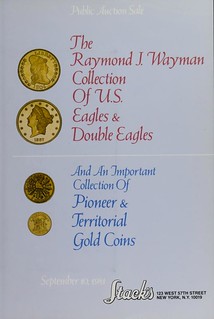 Our impressive 1981 auction season continued in September when we were able to offer the collection of Raymond J. Wayman, a valued collector whom we served for decades. The collection was mainly United States gold $10 and $20 pieces along with an outstanding selection of private and territorial coinage. Ray Wayman had an office a few blocks from Stack's and whenever he had some spare time he would wander over to our shop to see if something new and interesting had arrived. He loved Mint State and Proof coins, and exhibited great patience as he waited for coins of the quality he desired to become available. However, after chasing about to try and buy only those grades, he came to realize that sometimes Extremely Fine or About Uncirculated examples were going to be the best he could get. However, beyond the grade, he bought only pieces that appealed to him; he would study pieces offered in our auctions or retail stock carefully before adding them to his growing collection.
Our impressive 1981 auction season continued in September when we were able to offer the collection of Raymond J. Wayman, a valued collector whom we served for decades. The collection was mainly United States gold $10 and $20 pieces along with an outstanding selection of private and territorial coinage. Ray Wayman had an office a few blocks from Stack's and whenever he had some spare time he would wander over to our shop to see if something new and interesting had arrived. He loved Mint State and Proof coins, and exhibited great patience as he waited for coins of the quality he desired to become available. However, after chasing about to try and buy only those grades, he came to realize that sometimes Extremely Fine or About Uncirculated examples were going to be the best he could get. However, beyond the grade, he bought only pieces that appealed to him; he would study pieces offered in our auctions or retail stock carefully before adding them to his growing collection.
When Ray retired, he decided to sell his coins. His collection started with early eagles, continuing on to the Liberty series starting in 1838, of which he assembled a great representative collection. He also focused on the Indian Head design, and though not complete, he had an outstanding 1907 wire edge with periods. Among double eagles his collection was more complete, with many Mint State coins, rare mintmarks and some Proofs.
He loved the history of private and territorial coinage and finance. He collected examples from the Bechtler family, Norris, Gregg & Norris, the Mormons, Baldwin, Conway, Humbert, Oregon , Moffat, Parsons, Miners Bank, and other assayers. He read books, studied catalogs and enjoyed owning these historic pieces. Though the sale had but 446 lots, it became an important event, as specialist in gold coins made a real effort to attend and compete for the great coins that Ray had assembled.
To read the complete article, see:
Harvey Stack Remembers: Growing up in a Numismatic Family, Part 83
(https://www.stacksbowers.com/News/Pages/Blogs.aspx?ArticleID=harvey-stack-remembers-part-83)
To read the earlier E-Sylum article, see:
HARVEY STACK'S NUMISMATIC FAMILY, PART 82
(https://www.coinbooks.org/v23/esylum_v23n45a17.html)
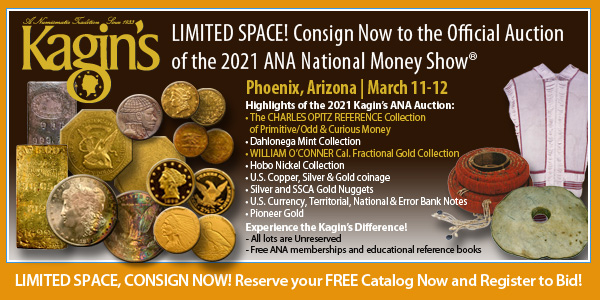
ARTICLE PROFILES MINT ARTIST ARTIST ELANA HAGLER
This Montgomery Advertiser article profiles artist Elana Hagler of the U.S. Mint's Artistic Infusion Program. -Editor

You'd think Montgomery artist Elana Hagler would be the at least one of the first in line to get the new President George H.W. Bush collectible coin from the U.S. Mint. After all, she did help design it, and it even has her initials stamped onto it.
"Nope, I have to order one just like everyone else," said Hagler, an assistant professor of art at Alabama State University.
The Bush coin will be available for purchase as of Dec. 4. It's part of the U.S. Mint's collection of presidential $1 collectible coins that have been issued for late presidents since 2007.
Back in August it was announced that her drawing of the late president had been selected to use on the coin. Hagler, who is part of the U.S. Mint's Artistic Infusion Program, is one of several artists who submitted work for the project.
Hagler, a mother of two, has had work exhibited nationally and internationally. She is an immigrant who was born in Tel Aviv, Israel. Her family emigrated to Los Angeles in 1985 when she was 5 years old.
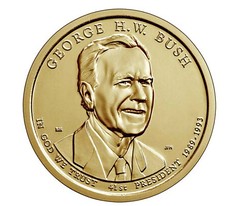 Hagler's drawing of Bush, who served as vice president from 1981-1989 and then as president from 1989-1993, was selected by both recommendation groups for the coin project, as well as the Bush family. Bush died in 2018 at 94.
Hagler's drawing of Bush, who served as vice president from 1981-1989 and then as president from 1989-1993, was selected by both recommendation groups for the coin project, as well as the Bush family. Bush died in 2018 at 94.
This is Hagler's first time to have one of her designs minted. She complimented U.S. Mint Chief Engraver Joe Menna for his sculpture of her drawing.
"Trying to decide whether I should order a bag or a box," Hagler said.
One person in particular who is getting a Bush coin from Hagler is her grandmother, who was an avid coin collector in her youth in Russia.
"I can't wait to give it to her," Hagler said.
To read the complete article, see:
President George H.W. Bush collectible coin features drawing by Montgomery artist Elana Hagler
(https://www.montgomeryadvertiser.com/story/news/2020/11/19/george-h-w-bush-collectible-coin-features-drawing-montgomery-artist/3776046001/)
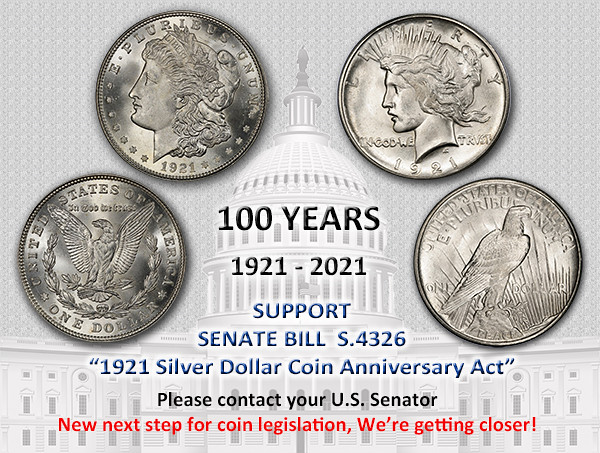
PAN'S COVID-19 COMPLIANT FALL 2020 SHOW
The Pennsylvania Association of Numismatists pulled off a great show this fall despite the pandemic. Here's how they did it - with hard work, determination, and a good dose of humor. -Editor
PAN Fall Coin Show a Covid-19 Compliant Success!
by Patrick McBride, PAN eNews editor
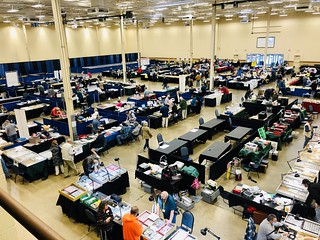 The PAN Fall Coin Show was successfully held on October 29th – 31st 2020 at the Monroeville
Convention Center, near Pittsburgh, PA, with Covid-19 guidance and rules in place. The PAN Board
came up with a detailed Covid-19 Protocol that was proposed to both the convention center and the
Allegheny County Health Department in the weeks leading up to the show. PAN's Covid-19 Protocol
outlined in detail the components needed to keep people safe while hosting a larger regional coin show.
Both the health department and the convention center approved the PAN Covid-19 Protocol and our
show moved forward!
The PAN Fall Coin Show was successfully held on October 29th – 31st 2020 at the Monroeville
Convention Center, near Pittsburgh, PA, with Covid-19 guidance and rules in place. The PAN Board
came up with a detailed Covid-19 Protocol that was proposed to both the convention center and the
Allegheny County Health Department in the weeks leading up to the show. PAN's Covid-19 Protocol
outlined in detail the components needed to keep people safe while hosting a larger regional coin show.
Both the health department and the convention center approved the PAN Covid-19 Protocol and our
show moved forward!
The first hurdle was to assure that event attendance would remain under the allowed capacity restrictions of the convention floor space. We were able to book the much larger North Hall area of the convention center that easily allowed us to fall under the 1,500 persons per day restriction. Our normal (pre-Covid) attendance is about 350 persons per day and 150 dealers and helpers on the show floor. This larger space allowed us to place dealer booths with three foot spacing between each booth with ten feet aisles. Since coin shows typically only have one or two dealers behind a single eight-foot table, this action reasonably assured that each dealer would be at least six feet from his or her neighbors. Dealers were cognizant to not move close to their neighbors if they went from side to side to service their customers.
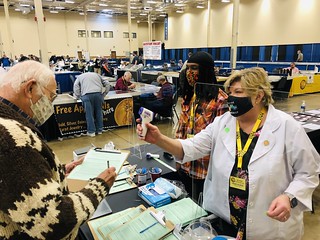 PAN required daily Covid-19 registration forms to be filled out by all attendees, dealers, early birds,
staff, convention workers, and security personal. A registered nurse administered temperature checks
with the parameters of 100 degrees or less before admittance was granted. The forms included basic
questions about general health and known exposures to anyone that has had Covid-19. They also
included a liability wavier protecting staff, PAN and the Monroeville Convention Center. The forms
were signed and dated. Different colored forms were used each day and each person was given a same
colored small round sticker to place on their hello registration labels that they wore while on the show
floor. This practice gave assurances that the person was properly screened and would allow attendees
and dealers to re-enter the convention center without being rescreened. Since the participating dealers
were in attendance all days, we had a specific color for a one time only dealer specific Covid-19
Registration form but they had to verbally answer the health questions and be temperature checked each
morning by our nurse. They would be given the same round colored stickers as the public to place each
day on their dealer badges. This made for great ease and speed in the early mornings for them to get to
their tables to prepare for the day.
PAN required daily Covid-19 registration forms to be filled out by all attendees, dealers, early birds,
staff, convention workers, and security personal. A registered nurse administered temperature checks
with the parameters of 100 degrees or less before admittance was granted. The forms included basic
questions about general health and known exposures to anyone that has had Covid-19. They also
included a liability wavier protecting staff, PAN and the Monroeville Convention Center. The forms
were signed and dated. Different colored forms were used each day and each person was given a same
colored small round sticker to place on their hello registration labels that they wore while on the show
floor. This practice gave assurances that the person was properly screened and would allow attendees
and dealers to re-enter the convention center without being rescreened. Since the participating dealers
were in attendance all days, we had a specific color for a one time only dealer specific Covid-19
Registration form but they had to verbally answer the health questions and be temperature checked each
morning by our nurse. They would be given the same round colored stickers as the public to place each
day on their dealer badges. This made for great ease and speed in the early mornings for them to get to
their tables to prepare for the day.
The Covid-19 forms were surprisingly met with little resistance. No dealers refused to comply. We made sure to inform them before they traveled to the PAN show. Only one attendee was not comfortable with the form and chose not to enter. We expected show attendance to fall to about a sixty percent range of normal. We were very surprised to see a long line of public waiting to enter on Thursday, day one. This set the tone for the weekend. The public responded enthusiastically with our final attendance figures coming in at almost the same number as our fall 2019 show before anyone knew about the Covid-19 virus. The final numbers were dealers and helpers 149, early birds 27, public attendees Thursday 335, Friday 396, and Saturday 307.
Everyone adhered to the required wearing of facemasks. We found that most people did wear their masks in the proper fashion with them covering both their mouths and noses. We also were pleased with the number of dealers that policed each other about the proper wearing of their masks. We are now well past the standard fourteen-day window and can report that we have had no notifications of adverse medical incidents related to our event! This has been a major concern of our PAN board members. We actually had two members that were slated to play a very active role during the show and had to cancel at the last minute over concerns of a possible covid exposure. We were thankful to find out that they both checked out negative and made it unscathed through their quarantine periods.
This show was very difficult to organize. We were not sure if the convention center would be allowed to open until a couple of weeks prior to our event. This put our normal show advertising at a disadvantage especially with the print media that requires a significant lead-time. Our focus shifted to our 4,000-person mailing list, our 1,300-email list, and social media postings. It was quite impressive given these handicaps that we were able to pull it off.
Some other pleasant surprises were being able to have a few quickly organized lectures on Friday and Saturday with John Frost of the Liberty Seated Collectors Club and the Barber Coin Collectors' Society presenting talks including a very interesting one about the back story of the rarity of the 1894-S Barber Dime. Simcha Kuritzky of the Maryland State Numismatic Association presented a talk on Polymer Notes. It was noteworthy that the attendance was about the same as our pre-covid talks. All chairs were spaced at six feet apart.
PAN was able to have a collector exhibit area managed by Exhibit Chairman Tom Corey. Even with less than normal participation, we still were able to have a respectable showing with ten very fine exhibits. Because of the limited participation, the exhibits were deemed as non-competitive and were not judged by categories under normal ANA judging guidelines. It was decided to award recognition to a "Judges Favorite" category that was unofficially created to at least have some fun for the exhibitors and the eight ANA certified judges that were attending the show. The ANA judging guidelines were set-aside for this unprecedented time. The judges chose Bryce Doxzon's interesting exhibit titled "They Also Ran – Select Nineteenth Century Political Medals of Defeated Presidential Candidates." Bryce's exhibit has appeared nationally at various shows and is a definite eye catcher.
Robert O. Stakeley, History Center Affiliates Program Coordinator from the Senator John Heinz History Center Pittsburgh, PA presented a limited PANKidZone program. KidZone Chairman Malcolm Johnson prepared packets that included a penny folder, two rolls of wheat cents, various other coins, PAN Auction Dollars. Attendance was about one third of normal that can be due to Covid or Halloween falling on the same Saturday. The good news for the kids that were in attendance is that they really got some good bargains during the kid's auction since the competition was not there.
William Bierly author of his recent Whitman Publishing book release, "In God We Trust" was another pleasant surprise at the PAN show. Bill had signed copies for sale at the collector exhibit area. Copies of this fine work on our national motto can be purchased on the Whitman website: https://whitman.com/in-god-we-trust/
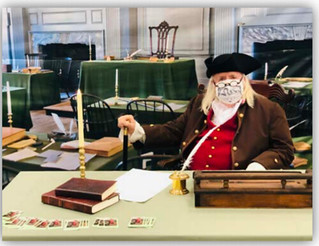 We also had yours truly appearing as Benjamin Franklin in plague compliance with his "Join or Die"
mask as part of his costumed regalia. I was not sure that reenacting would be suited to a restricted show
but I was encouraged to come in character on Friday and Saturday. Even masked, old Ben was very
popular and folks were glad to see the good Doctor roam the show floor. It added a fun and lighthearted
feel to the days. Goodness knows we all could use some fun while dealing with these days of living
through a worldwide pandemic.
We also had yours truly appearing as Benjamin Franklin in plague compliance with his "Join or Die"
mask as part of his costumed regalia. I was not sure that reenacting would be suited to a restricted show
but I was encouraged to come in character on Friday and Saturday. Even masked, old Ben was very
popular and folks were glad to see the good Doctor roam the show floor. It added a fun and lighthearted
feel to the days. Goodness knows we all could use some fun while dealing with these days of living
through a worldwide pandemic.
We would like to extend a special thank you to our PAN nurse, Dawn McBride for creating the Covid- 19 forms and volunteering her time for all four days of the show. Her nursing oath to keep us all healthy and safe cannot be understated since many of our dealers and attendees fall into the high-risk category. We are grateful to have such a compassionate person in our midst. Dawn recently retired from the University of Pittsburgh where she was serving as the Director of Clinical Research in a department that specializes in urological cancers. Dawn spent the last 25 years of her nursing career in research, including 13 years in Infectious Diseases that focused on vaccine research, specifically in the HIV/AIDS community. We also want to thank her helper through the entire weekend Zavier Layne for getting people through the line quickly and efficiently. Zavier was a huge asset to the registration process with his friendly and polite manner.
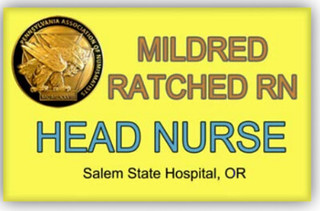 The final day of the show fell on Halloween so we made this special badge for Dawn. Being the good
sport, she wore it all day Saturday and made sure that everyone followed her rules.
The final day of the show fell on Halloween so we made this special badge for Dawn. Being the good
sport, she wore it all day Saturday and made sure that everyone followed her rules.
Inquiries are welcome at pancoins@gmail.com
For more information on PAN, see:
https://pancoins.org/
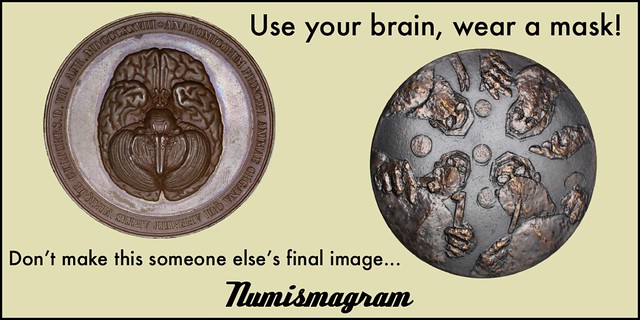
COLTRANE 1776 NORTH CAROLINA HALIFAX NOTE SET
Stu Levine, Bruce Hagen, and Maureen Levine submitted this preview of Halifax notes in the upcoming Heritage sale of the Mike Coltrane Collection of North Carolina Currency. -Editor
The Mike Coltrane Collection
Mike Coltrane collected notes from his native North Carolina from Colonial times to the modern era. Perhaps his greatest collecting achievement was attaining a complete set from the April 2, 1776, "at Halifax" issue. This is among the most interesting series of all Colonial notes. There are 56 distinct vignette types (seen at the lower left of each note), ranging from $1/16 to $20 denominations, and all of them merit consideration and further study. Certain types appear on different varieties of paper, depending upon what was available at the time of printing. Few collectors, including several advanced Colonial note specialists, have managed to obtain all 56 types (even the Boyd Estate holding was not complete, despite decades of access to major collections), but Mike Coltrane accomplished this worthy endeavor. High-grade notes on many vignette types are unknown to us. All will be offered unreserved at auction on November 29, 2020, by Heritage Auctions.
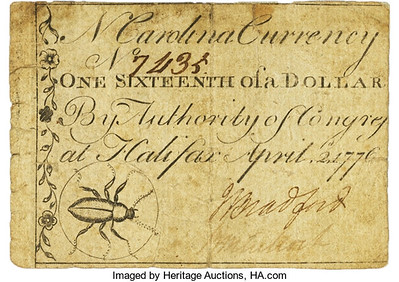
North Carolina April 2, 1776 $1/16 Beetle Fr. NC-153a PMG Very Fine 20
The six different $1/16 notes are among the most difficult of the denominations to find in all grades. They were needed for small change and printed on thin paper that split readily. This ‘Beetle" is among the finest and is ex: Eric P. Newman Collection. Lot 95068.
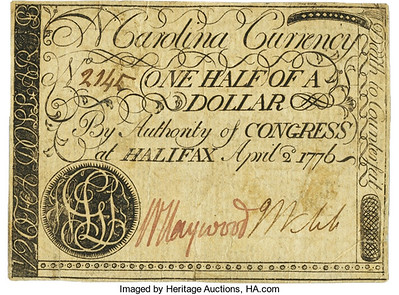
North Carolina April 2, 1776 $1/2 GL in White Script with Toothed Border of Radial Lines Monogram Fr. NC-156f PCGS Very Fine 35
The monogram types from the series are rather mysterious and differ greatly from the variety of animals, sea creatures, and patriotic themes seen on other notes. Lot 95101.
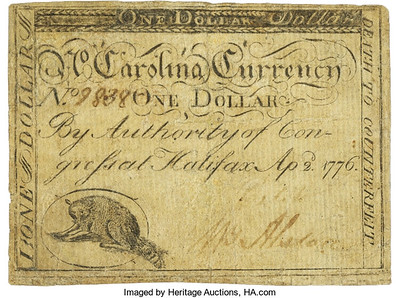
North Carolina April 2, 1776 $1 Raccoon Fr. NC-157b PCGS Fine 15
Several of the $1 notes are among the rarest in the series. This is another denomination that widely circulated concurrently with the Continental Currency. The fact that the "Raccoon" type was missing from the Boyd Collection attests to its great rarity. Lot 95109.
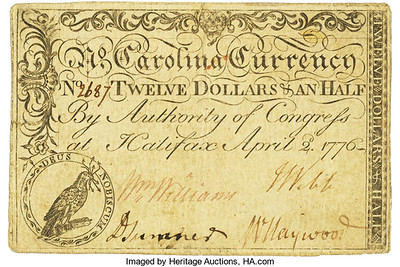
North Carolina April 2, 1776 $12 1/2 Eagle Fr. NC-167 PMG Choice Extremely Fine 45
One of several unusual denominations (there were also $2-1/2, $7-1/2, and $15 notes) in the series. Rare with only 3,000 authorized. A well-printed example with strong vignette details. Lot 95135.
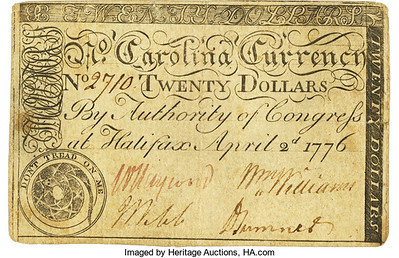
North Carolina April 2, 1776 $20 Rattlesnake Fr. NC-169 PMG About Uncirculated 50
The highest denomination from the issue and with the Revolutionary War motto DON'T TREAD ON ME with a coiled rattlesnake. Popular with all Colonial note collectors. Lot 95137.
This important collection, featuring 385 lots, will be auctioned online on Sunday, November 29, 2020, commencing at 6:00 PM Central Time (7:00 PM Eastern). For further information please contact Jose Berumen at JBerumen@ha.com or 214-409-1299. All lots are currently on view and open for bidding now at ha.com/62155.
To read earlier E-Sylum articles, see:
COLTRANE NORTH CAROLINA CURRENCY TOUR
(https://www.coinbooks.org/v23/esylum_v23n46a19.html)
THE CROW, THE PITCHER, AND THE PEBBLE
(https://www.coinbooks.org/v23/esylum_v23n44a25.html)
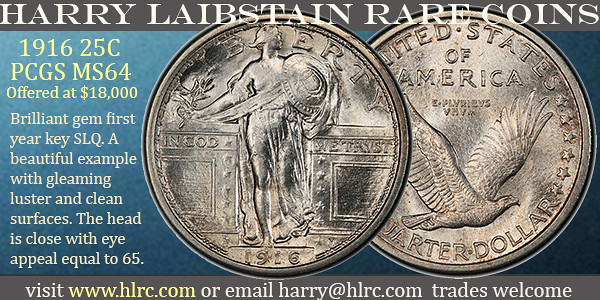
NUMISMATIC NUGGETS: NOVEMBER 22, 2020
Here's a selection of interesting or unusual items I came across in the marketplace this week. Tell us what you think of some of these. -Editor
c1550 Nuremberg Alphabet Tokens
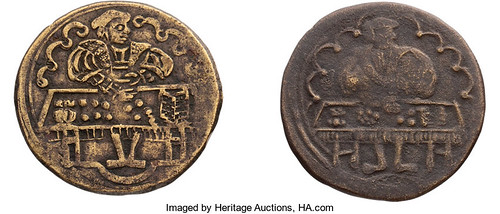
Two Nuremberg Alphabet Tokens. ca. 1550s. "Rechenmeister" coins embossed with a counting master on one side and the alphabet letters in upper case on the other. The two tokens are similar; however, one includes a date beneath the alphabet letters [1558 or 1559?] and is rubbed. There are also slight variations in alphabet order: one lacks j and u, while the other lacks j and u and w (but has a second n at the end). Copper or brass alloy; each measuring roughly 1-inch (26 mm) in diameter. Very good.
The earliest alphabet and math tokens date from 1550s Nuremberg. Later versions were cast with Biblical or Royal imagery, and were usually imprinted with the date and name of the manufacturer. This particular style of alphabetical token appears to be "Schoolpenning," or "school token" popular among schoolchildren.
Caelenberghe, H. van, Hasselt, H., & Kronenberg, H. (2001) "Rekenpenningen, de makers het gebruik en de gescheidenis". The Coinhunter Magazine No.77. W S Churchill, "Nuremberg Alphabetical Tokens", Transactions of the Lancashire and Cheshire Antiquarian Society XX (pages 117-118).
From the December 16, 2020 Heritage Rare Children's Literature sale. I was unfamiliar with alphabet tokens before seeing this. Interesting. E-Sylum readers have a special love for words, and what are words without the alphabet? There's a new book on the history of alphabetical order by Judith Flanders: A Place for Everything: The Curious History of Alphabetical Order . From dictionaries to encyclopedias to book indexes, we take alphabetical order for granted today. But as with everything from the spoken word to letters, printing, books and even the bookshelf itself, all had to be invented along the way. Something for the curious bibliophile to add to their holiday wishlist. -Editor
To read the complete lot description, see:
Two Nuremberg Alphabet Tokens. ca. 1550s. "Rechenmeister" coins embossed with a coun...
(https://historical.ha.com/itm/books/children-s-books/two-nuremberg-alphabet-tokens-ca-1550s-rechenmeister-coins-embossed-with-a-coun/a/6234-45226.s)
India Mughal Empire Mohur
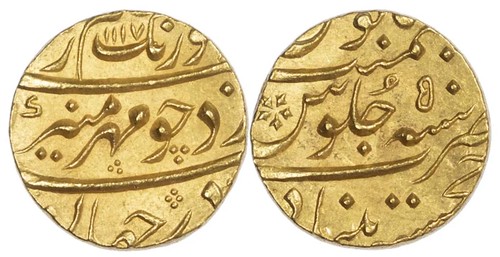
India, Mughal Empire, Aurangzeb (1658-1707), AV small flan Mohur (10.96gm.) of the mint Khujista Bunyad, 1117h. Yr 50, (AD 1707). [last few months of reign], (KM. 315.30; ICV 4284).
Good Extremely fine with some original mint bloom.
An attractive coin. I know nothing of the language, but find these kinds of coins seductive in their simplicity. From the online stock of Baldwin's. -Editor
To read the complete lot description, see:
INDIA, MUGHAL EMPIRE, AURANGZEB, MOHUR, KHUJISTA BUNYAD
(https://www.baldwin.co.uk/product/india-mughal-empire-aurangzeb-mohur-khujista-bunyad/#tab-description)
1791 Italy 1 Piastra
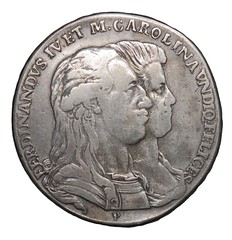
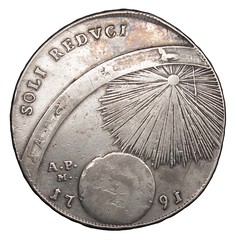
Italy, Naples and Sicily, 1 Piastra, 1791, FERDINANDVS IV. ET M. CAROLINA VNDIQ. FELICES P., portraits of Ferdinand IV of Naples and Maria Carolina of Austria, king and queen of Naples conjoined to right. Rev. SOLI REDUCI, A.P. M. 1791, Sun with rays, zodiacal signs and a terrestrial globe centered on Italy. (KM. 213; G. 59; MIR 372). About Very fine.
Commemorative coin: return of Ferdinand IV to Naples. The zodiacal signs represent the months after the King and Queen left Naples for the royal family's visit to Vienna, symbolizing the wait of Naples people for the return of their sovereign.
The unusual reverse caught my eye. Coins and medals depicting astrology and astronomy are an interesting numismatic sideline. Also from Baldwin's. -Editor
To read the complete lot description, see:
ITALY, NAPLES AND SICILY, FERDINAND IV, 1 PIASTRA, 1791
(https://www.baldwin.co.uk/product/italy-naples-and-sicily-ferdinand-iv-1-piastra-1791/)
1917 Canadian Bank of Commerce $20
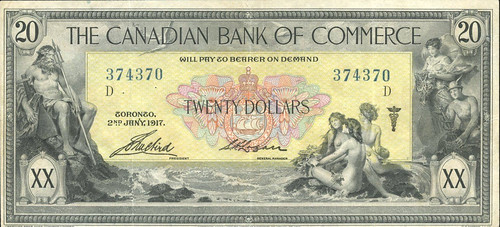
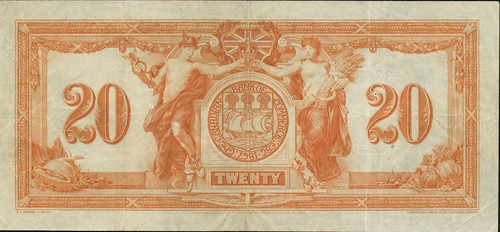
From the Geoffrey Bell Moncton November 2020 Sale. Beautiful note. -Editor
To read the complete lot description, see:
Canadian Bank of Commerce $20, 1917
(http://auctions.gbellauctions.com/Canadian-Bank-of-Commerce-20-1917_i39070546)
1876-CC Half Eagle
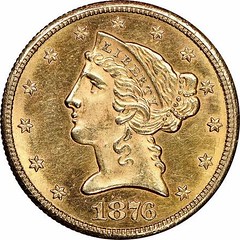
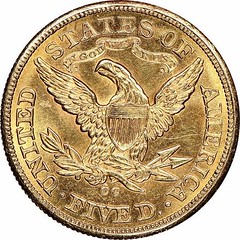
United States of America, Gold $5 1876 CC, Liberty Head, Carson City, by Christian Gobrecht, edge milled, 6h (Winter dies 1-A; PCGS #8340 [0 of 0 / 1 Finer]; NGC ID #25WX [*Single Finest*]).
Only the third example to achieve the exalted Mint State grade at either NGC or PCGS, rendering this coin finer than the Hansen (PCGS AU58); Harry Bass (PCGS AU58) or Smithsonian National Museum (PCGS AU50) Set Registry pieces, and an exceptional second behind only the revered Chapman Bros-Clapp-Eliasberg-Lang-'Battle Born' [Goe] coin, a truly wonderful discovery piece that is sure to get even the keenest Carson City collectors excited in the year of the Branch Mint's Sesquicentenary!
From the upcoming Spink December 14, 2020 sale. Great coin! -Editor
To read the complete lot description, see:
A NEW DISCOVERY: THE SECOND FINEST 1876 CARSON CITY HALF-EAGLE NGC MS62 [TOP POP AT NGC]
(https://live.spink.com/lots/view/4-1BBCD9/a-new-discovery-the-second-finest-1876-carson-city-half-eagle-ngc-ms62-top-pop-at-ngc)
THE BOOK BAZARRE
POLITICS OF ANCIENT NUMISMATICS
The November 2020 American Numismatic Association blog features a 2017 Numismatist article by John Nebel. Here's an excerpt, but we sure to read the complete piece online. -Editor
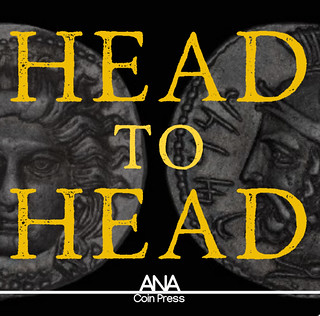 Politics plays a part in all facets of ancient numismatics, from original coin design and production to modern-day purchases.
Politics plays a part in all facets of ancient numismatics, from original coin design and production to modern-day purchases.
Politics and coinage are inextricably linked. In the ancient Greek world, coins were issued by poleis (city-states), kingdoms or the Persian Empire. In terms of sheer quantity, poleis dominated, and perhaps as many as 700 issued their own coins. Such pieces usually depicted or otherwise honored the god or hero who protected the city's populace, or featured a design immediately recognizable as the badge of the polis.
Even today, politics influences numismatics and collectors. I experienced this firsthand when U.S. Customs and Border Protection (CBP) detained and held three ancient coins I had purchased in a numismatic auction in Switzerland: a Lydian stater, an Akanthos tetradrachm and a Tarsos stater. In the course of an apparently random audit, the government agency took an interest in these coins on October 12, 2016, when the pieces entered the United States in a Federal Express® package. A customs agent said my numismatic shipment was not the only one being reviewed, assuring me that I had not been deliberately singled out. Nevertheless, once CBP decided to take a look, it was thorough. The usual documents provided by the auction house were not enough. As one CBP agent stated, "[The auctioneers] don't necessarily know if the coins were stolen."
In December 2016, I received a detention form that verified the coins were in CBP's possession, "just so you know we haven't lost them," a customs official explained. A phone call from a CBP agent in early February clarified what was necessary to obtain the coins' release. Foremost, it required documentation that the tetradrachm had left Greece before November 21, 2011, and that the two staters were outside Turkey before April 21, 1981. The CBP considered the latter coins to be Turkish, because that country governs the land formerly occupied by the mint where they originally were struck. Alternatively, CBP could ask the Turkish government via the U.S. attaché in Athens whether the coins, potentially subjects of a 1906 Ottoman imperial decree, had been removed illegally from Turkey (the successor of the Ottoman empire) and therefore were state property.
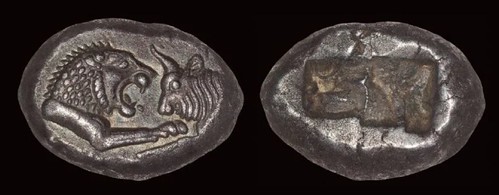
Lydia, Kroisos silver stater (561-546 B.C.). Photos: John Nebel
Coin Stories
All three coins are wonderfully beautiful, and each tells a story. The stater is readily identified by the image of a lion and a bull, head-to-head on the obverse. The motif was the badge of Kroisos, king of Lydia from 560 to 546 B.C. Originally, all Lydian coinage was electrum, an alloy of gold and silver. Culturally, the issuers of those early coins were Greek poleis situated within the Lydian empire. Separately, Kroisos' lineage, the Mermnadai, had established the lion as its badge. Symbols of power and light, a roaring lion and the sun appeared on its coinage.
Kroisos added the bull, originally conjoined with the lion head. This soon was replaced by the confrontational image—more natural and certainly more striking. At the same time, Kroisos initiated a practical change—a bimetallic coinage system of gold and silver. Herodotus wrote, "[The Lydians] are the first of the men of whom we know to cut and use a currency of gold and silver." The value of the silver issues was low enough to allow their use in everyday commerce, while the coins of both metals were close enough in size, according to Ian Carradice in Coinage and Administration in the Athenian and Persian Empires, that "dies are shared between examples with different sizes and weights, and between gold and silver pieces."
John is the backbone of all Numismatic Bibliomania Society online efforts, having offered free hosting for our website since the beginning, and working with us on every upgrade. Our site now hosts a complete archive of over 30,000 E-Sylum articles, made possible by his continued generous support. He's quite a numismatic photographer as well, as evidenced by the photos in his article. Check it out. -Editor
To read the complete article, see:
HEAD TO HEAD: POLITICS OF ANCIENT NUMISMATICS
(https://blog.money.org/coin-collecting/head-to-head)

A NEW STUDY ON THE ORIGINS OF COINAGE
Andrew Meadows will lead a new Oxford study on the origins of coinage. -Editor
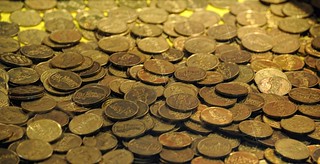 A new project investigating the origins of money has been announced by the Faculty of Classics at Oxford University.
A new project investigating the origins of money has been announced by the Faculty of Classics at Oxford University.
The project is set to last five years and will look into the origins and concept of coinage. Termed the ‘CHANGE Project', the investigation will be led by Professor Andrew Meadows, a Fellow and Tutor in Ancient History at New College.
A sum of €2 million has been awarded to the project in the form of a Consolidator Grant by the European Research Council to help fund the project for its anticipated duration.
Project leader Professor Meadows said: "We hope to generate a new account of the beginning of coinage and its rise as a monetary medium."
To achieve this, the project aims to gather evidence that will illuminate the history surrounding the development of the economy involving money.
As a result, it is centred around the geographical region of Anatolia (Asia Minor), where money is said to have been invented. The time period covered will range from 7th Century BC to roughly 30 BC, after which point Anatolia was absorbed into the Roman Empire.
As part of the investigation, a database of around 50,000 coins will be assembled in multiple public collection to create a complete overview of the period. In addition, it will bring together a checklist of inscriptions as sources that recorded monetary exchanges. Professor Meadows added: "This data will permit a detailed mapping of movement of coinage over time and place, and allow the exploration of monetary behaviour across political and geographical space."
In order to gather the data and research materials needed, a group of museums and collections are involved, including the Münzkabinett, Staatliche Museen zu Berlin, and the British Museum. Professor Meadows had previously worked as the ‘Curator of Greek Coins' at the British Museum.
Found via The Explorator newsletter. To subscribe to Explorator, send a blank email message to: explorator+subscribe@groups.io. -Editor
To read the complete article, see:
Oxford project to research origins of coinage
(https://cherwell.org/2020/11/17/oxford-project-to-research-origins-of-coinage/)
A NEW STUDY ON ANCIENT COUNTERFEITING
Arthur Shippee and Howard Berlin passed along this Jerusalem Post story about a new study on ancient counterfeiting. Thanks. -Editor
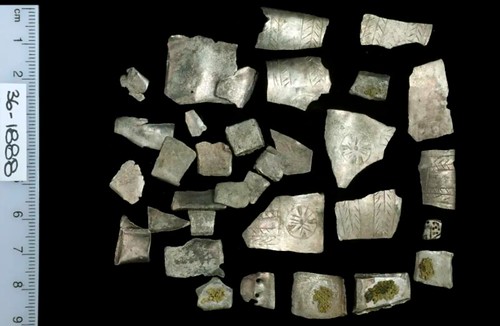
Ancient counterfeiting is the subject of a new joint study by the University of Haifa and the Hebrew University of Jerusalem that will be published in the upcoming issue of the Journal of Archaeological Science. The study found evidence of a severe shortage of silver in the Levant during the first Iron Age (between 1200-950 BCE), the period when the tribes of Israel settled in Canaan, which led to the creation of silver made with a high percentage of copper.
"The small percentage of silver in the pieces of silver, which were mixed with other substances such as arsenic that made them appear silver in color... reinforces the hypothesis that at least for part of the period, it was a deliberate forgery," the researchers said.
According to the researchers, at that time no coins had yet been minted, and trading was done using silver pieces that were not uniform, so the amount of silver in each piece was important.
As part of Eshel's doctoral dissertation and other previous studies, it has been established that silver earrings from the area from earlier periods (starting from 1900 BCE) were made of almost 100% silver, as were those from later periods. However, when the researchers examined the chemical composition of these Iron Age caches, they found that they were made of an alloy composed mainly of copper, with the copper content as high as 80% in certain pieces.
The researchers also found that substances such as arsenic were also added to these alloys, in order to give the ingot a silver color. While the researchers said there was no conclusive evidence that this was a forgery, they feel that there was a deliberate attempt to simulate the silver color of these metal pieces.
"In addition to the fact that there was a deliberate attempt to paint the metal silver, we found that in the ancient caches the percentage of copper was higher and the amounts of arsenic were very similar from piece to piece," they wrote.
Eshel writes that: "In the book of Ezekiel in Chapter 22, the prophet prophesies that he is angry with God over the children of Israel and says: ‘Son of man, the people of Israel have become dross to me; all of them are the copper, tin, iron and lead left inside a furnace.'
"The sentence itself is of course a metaphor for the relationship between God and the children of Israel," she concludes. "But in practice, it is quite possible that it describes a reality that was familiar at the time: A silver ingot was mixed with various metals such as tin, iron and ore."
To read the complete article, see:
Dirty old money: Researchers reveal Iron Age silver forgery
(https://www.jpost.com/israel-news/dirty-old-money-researchers-reveal-iron-age-silver-forgery-649864)
Paul Horner passed along this related article from the Times of Israel. Thanks. -Editor
To read the complete article, see:
Archaeologists identify early Israelite-era attempts to forge ‘dirty' currency
(https://www.timesofisrael.com/archaeologists-identify-early-israelite-era-attempts-to-forge-dirty-currency/)

ROBERT I. NESMITH'S TREASURE HUNTER BROTHERHOOD
Tom Kays is a regular member of my Northern Virginia numismatic social group Nummis Nova. We've been holding monthly Zoom sessions in lieu of our normal restaurant get-togethers. Tom kindly provided this report on November's event and one of the neat items he exhibited. Thanks! -Editor
The Nummis Nova Supper Club met by Zoom last Tuesday. As vacuous as the appetizers were, so too, the main course was entirely too airy and insubstantial for my palate, and for dessert... don't get me started. I would not recommend Zoom as a restaurant substitute if one is hungry. Be that as it may, it was good to see a few of the old crowd in the comfort of their homes and libraries. We had time to walk around our desks and peer into the stacks of our numismatic libraries. Different hosts plucked interesting books from their customary nooks and shared them as one would a bedtime story. Here is what I picked.
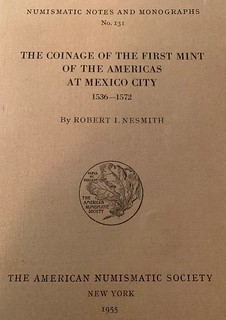
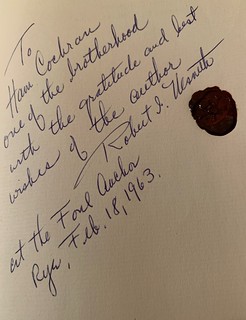
I pulled ANS Numismatic Notes and Monographs #131, The Coinage of the First Mint of the Americas at Mexico City 1536 – 1572 by Robert I. Nesmith, published in 1955 and shared a most curious inscription from the author on the flyleaf.
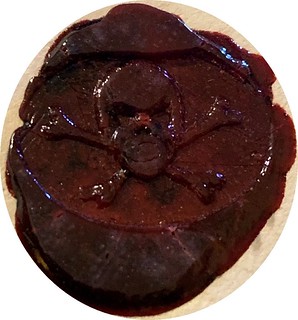 In what was once blood red sealing wax, Robert finished his dedication with a
flame and drops of crimson on the page, in which he pressed what I envision to be
a gold signet ring, leaving a most impressive flourish of skull and crossbones.
Dedicated
In what was once blood red sealing wax, Robert finished his dedication with a
flame and drops of crimson on the page, in which he pressed what I envision to be
a gold signet ring, leaving a most impressive flourish of skull and crossbones.
Dedicated
To Hans Cochran, one of the Brotherhood with the gratitude and best wishes of the author – Robert I. Nesmith - at the Foul Anchor - Rye, February 18, 1963.
Robert sure left a lasting impression.
Who was Robert I. Nesmith you ask? In Kiplinger's Personal Finance Newsletter "Changing Times" of May 1956, this advertisement appears: "Hints to Treasure Hunters: "If you want to pay for expert advice on a given problem, write to Robert I. Nesmith, Foul Anchor Archives, Rye N.Y. he is a recognized authority on old coins, and he has authentic records on the never-ending search for buried treasure."
Another tip for treasure hunters reads: "Don't go plunging off after sunken or buried treasure without reading available literature or consulting an expert in the field. A couple of months ago a man got steamed up about finding gold, silver and crown jewels of Maximillian, which were said to have been in the safe of the Ward liner Merida when she sank off the Virginia Capes on May 12, 1911. Fortunately, the prospective treasure hunter checked with Robert I. Nesmith of Rye, N.Y., who quickly proved that several expeditions had searched for the Merida and that one had finally found her at a considerable expense and pulled up the safe. Inside were three disks: a waiter's badge, numbered 13, a Mexican copper coin and a counterfeit U.S. 50-cent piece. Research showed that the ship had been rammed at midnight and not abandoned till five hours later. The purser had had plenty of time to empty the safe."
In the ANS Monograph #131, Robert Nesmith writes that his study of the earliest coinage of the Americas was propelled by the scanty information and lack of knowledge about the circumstances of emission of coins from the Mexico City Mint. A series of articles written by Wayte Raymond in The Coin Collector's Journal of 1943-44 proved this point. In introduction Robert Nesmith explains:
After conquering Mexico, Hernan Cortes sailed back to Spain in 1540, complaining about Viceroy Mendoza to the crown, which prompted a thorough government investigation. Francisco Sandoval probed into the doings at the mint in Mexico from 1544 – 1547. He generated mounds of official records detailing much that coin collectors would never otherwise know about smelting, coining, weighing, and bookkeeping. Eventually Mendoza was cleared of wrongdoing and punishments meted out to underlings for various minor infractions since every Spanish inquisition must find someone at fault to justify the travel expenses of the inquisitors.
Robert Nesmith knew of the Archives of the Indies where official documents of the Spanish Empire including original handwritten decrees, regulations, and appointments for New Spain from the 1500s still resided, untranslated in archaic Spanish, at the Archives in Seville. The first English translation of the Royal Decrees establishing the Mexico City Mint on May 11, 1535 were published in his ANS Monograph #131. Robert studied many early Mexican coins in fine numismatic collections including at the American Numismatic Society, and the Banco de Mexico, S.A. As a capstone to his monograph, a large hoard of over one thousand coins from Carlos and Johanna to Philip II was unearthed in Mexico in the summer of 1952 which added to the varieties known.
Does anyone know who Hans Cochran is?
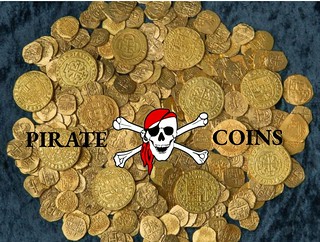 By the way... a new private group on Facebook formed this past week for those
who collect pirate coins. Dedicated to showing off, sharing, buying, selling,
trading, and auctioning off "pirate coins" they define pirate coins as those of
Spain and Portugal – and their colonies in Central and South America from 1474
till 1830. Also coins of the West Indies, Danish West Indies and Dutch West Indies
from 1740 to 1913 along with shipwreck coins and artifacts. What better
examples than these first coins of Mexico, in circulation at the rise of the Age of
Piracy and throughout, as likely coins to be inducted into a set of cobs and
hammered coins, minted back when swashbuckling was in vogue.
By the way... a new private group on Facebook formed this past week for those
who collect pirate coins. Dedicated to showing off, sharing, buying, selling,
trading, and auctioning off "pirate coins" they define pirate coins as those of
Spain and Portugal – and their colonies in Central and South America from 1474
till 1830. Also coins of the West Indies, Danish West Indies and Dutch West Indies
from 1740 to 1913 along with shipwreck coins and artifacts. What better
examples than these first coins of Mexico, in circulation at the rise of the Age of
Piracy and throughout, as likely coins to be inducted into a set of cobs and
hammered coins, minted back when swashbuckling was in vogue.
I'd never seen a wax seal used in a book like this. Did Nesmith sign other copies this way? Has any other author done such a thing? Great idea, and very cool. -Editor
To visit the Facebook Pirate Coins page, see:
PIRATE COINS - Buy, Sell, Trade & Auction
(https://www.facebook.com/groups/767691483783404/?ref=share)
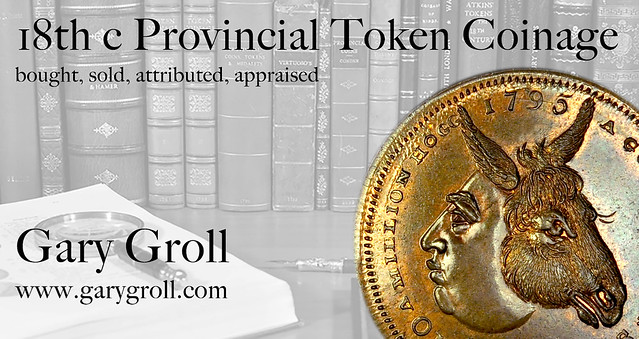
1813 NEW SOUTH WALES 15 PENCE 'DUMP'
Stack's Bowers Senior Numismatist and Cataloger Jeremy Bostwick published a blog article this week on the "Dump" and Australia's first coinage. In just a few short paragraphs Jeremy clearly lays out the need for and the thinking behind these fascinating pieces, and the reason for their great rarity today. -Editor
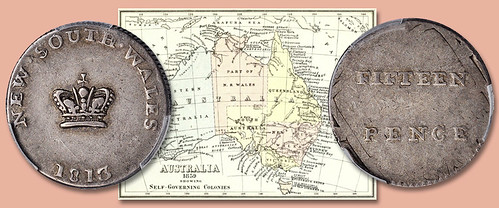
Having a native population going back some 60,000 years, Australia was first discovered by Europeans when the Dutch arrived in the early 17th century. A century later, the British arrived and in turn claimed half of the continent for themselves. The initial colony established there was New South Wales, and the British utilized this outpost as a penal colony to which the dominion's convicts could be sent. Not just prisoners would populate this southern realm, however, as the number of inhabitants in general grew rapidly in the late 17th- and early 18th centuries. So great was the growth that a complex bartering system existed, due to the lack of currency. To alleviate this shortage and ensure that the resulting coinage would not simply leave the colony as trading partners departed, a plan was devised whereby Spanish colonial 8 Reales—a trade coin par excellence around the world—would be holed out.
The "holed" pieces would then be stamped around the central hole identifying the colony, date, and—most importantly—the value. As these "Holey Dollars" were valued within New South Wales at 5 Shillings (about 20% more than they would be valued anywhere else on account of the loss of silver), their purchase power meant that they would remain in the colony averting another shortage. To make this process financially efficient, the resulting holes or plugs that were left over from the cored 8 Reales were also utilized—this time as a subsidiary coinage valued at 15 Pence. Again, the value stated on these repurposed plugs was higher in New South Wales than anywhere else, keeping them domestic as well.
In late 1812, 40,000 of these 8 Reales arrived in Australia, thus initiating the holing process; some eight months later, the coinage—both large and small—was made official and circulated quite extensively for a decade. As more British coinage would continue to find its way to the colony, however, the necessity of these issues dwindled; they were recalled in 1822 and eventually demonetized in 1829. As nearly everyone took advantage of the redemption program to exchange for British coinage, the survival rate of both denominations is quite low. Owing to their vast usage during that decade, many survivors are in heavily worn condition. Our upcoming January 2021 auction—an officially sanctioned auction of the NYINC—will feature one of these storied fractional issues. This 15 Pence denomination—affectionately known as a "Dump"—remains in an impressive state of preservation given the aforementioned degree of circulation. Grading PCGS VF-35, it is exceeded in the PCGS census by just one other specimen for its particular type.
To read the complete article, see:
The "Dump" and Australia's First Coinage
(https://www.stacksbowers.com/News/Pages/Blogs.aspx?ArticleID=australias-first-coinage-world-coin-of-the-week-stacks-bowers-galleries)
To read earlier E-Sylum articles, see:
MUSEUM ACQUIRES 1813 NEW SOUTH WALES HOLEY DOLLAR
(https://www.coinbooks.org/esylum_v14n53a16.html)
MORE ON HOLEY DOLLARS
(https://www.coinbooks.org/esylum_v15n02a16.html)
AUSTRALIA'S HOLEY DOLLAR AND DUMP
(https://www.coinbooks.org/esylum_v17n30a14.html)
HOLEY DOLLAR AND DUMP: MEASURE TWICE, CUT ONCE
(https://www.coinbooks.org/v21/esylum_v21n41a19.html)

COLLECTOR OUTRAGE OVER THE U.S. MINT
Coin World reported this week on collector outrage over the U.S. Mint. -Editor
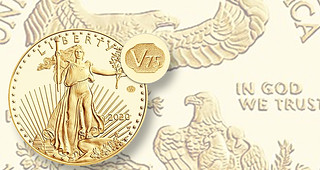 United States Mint officials seem so determined to drive away once loyal customers that one has to wonder whether their marketing decisions are deliberately aimed at shrinking the Mint's customer rolls.
United States Mint officials seem so determined to drive away once loyal customers that one has to wonder whether their marketing decisions are deliberately aimed at shrinking the Mint's customer rolls.
Mint officials are offering nothing more than empty platitudes in response to customer complaints about several offerings on Nov. 5 and Nov. 9, offers featuring coins and a medal celebrating the 75th anniversary of the end of World War II. As the small sampling of comments from readers in Coin World's Nov. 30 print edition "Guest Commentary" and "Letters to the Editor" columns show, both offerings were unmitigated disasters for many collector customers of the Mint.
Mint officials need to get out of the business of creating artificial rarities. Collectors are infuriated when they see a coin sold by the Mint for $2,600 being sold just a few days later for $13,000. They get especially angry and downright suspicious when well-heeled dealers acquire multiples of the coins and offer them to the public at vastly increased prices.
To read the complete article, see:
Monday Morning Brief for Nov. 16, 2020: What is the Mint doing?
(https://www.coinworld.com/news/us-coins/monday-morning-brief-for-nov-16-2020-what-is-the-mint-doing)
CoinWeek also addressed the issue in the form of an open letter to U.S. Mint Director David Ryder. Here's an excerpt - see the complete article online. -Editor
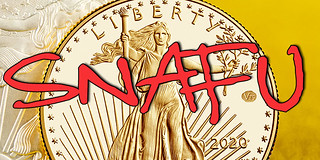 Not a day goes by that we do not receive angry emails from both collectors and established dealers in the rare coin market about the lineup, marketing, and rollout of the Mint's numismatic products. It would truly be exhausting to answer them individually, and so we devote most of our time to creating numismatic content that is meant to excite, inform, and benefit the collector.
Not a day goes by that we do not receive angry emails from both collectors and established dealers in the rare coin market about the lineup, marketing, and rollout of the Mint's numismatic products. It would truly be exhausting to answer them individually, and so we devote most of our time to creating numismatic content that is meant to excite, inform, and benefit the collector.
Therefore, it is unusual for us to form a response to one of these letters. But when, after a week of predictable sell-outs and manipulations takes place in connection with a highly anticipated Mint release and the Director of the Mint feels compelled to write his own letter, we feel that we should respond.
Just to be clear, Director Ryder, the professional numismatic community can be divided into two camps. There is the camp that would like nothing more than to see CoinWeek and other hobby publications grab a paddle and take the United States Mint and its numismatic products behind the woodshed and give it the business. And there is the other camp that looks for ways to take advantage of the U.S. Mint's customer base by building their own marketing concepts around the Mint's limited-edition product lineup and injecting themselves into the flow of these coins from the Mint to the collector.
Human nature and "Fear of Missing Out" (FOMO) play a role in all of this, of course. But from where we sit, nothing that happened with the rollout of the Mayflower collector coin and medal sets or the End of WWII privy mark program should have come as a surprise.
The profits that come from these offerings happen in the immediate aftermarket, with the repackaging of Mint products by third parties and the sale of these newly repackaged products by telemarketers and promoters. For the most part, these third parties do a better job marketing U.S. Mint material than the Mint does itself. They understand the powerful pull of FOMO and often reap huge profits by setting high prices and riding the tide down.
Now, the Mint has made an effort to reach out to the coin industry for feedback and insights in recent years, holding a number of annual numismatic forums (we assume one would have been held in 2020 were it not for the COVID pandemic). And having attended several of these forums ourselves, we are struck by two things: 1) the Mint expects its industry partners to bear the full cost of attending and giving the Mint what amounts to unpaid marketing insights, and 2) whenever industry stakeholders push them on understanding the Mint's role as a leader in the industry, Mint officials push back, saying that their hands are tied because they are a government agency and not a business.
Yet at the same time, Mint officials highlight in their annual report the fact that they have "produced over 24 million ounces of bullion and nearly 4 million units of numismatic products" and in the course of doing so have "achieved the status of being a top 100 e-commerce retailer according to Internet Retailer."
Achieving top 100 e-commerce retailer status is an extraordinary accomplishment given the niche nature of coin collecting, but it also serves as a clear reminder that the United States Mint is the largest coin dealer in the world and that it conducts its numismatic and bullion business completely aware of this fact.
To read the complete article, see:
Enough is Enough… The U.S. Mint Needs to Change
(https://coinweek.com/us-mint-news/enough-is-enough-the-u-s-mint-needs-to-change/)

U.S. NAVAL MEDAL OF HONOR AUCTIONED
"Last week's E-sylum had an item about the auctioning of many very nice Siamese and Thai orders and decorations. I used to collect Thai and looked through this outstanding collection.
"Out of curiosity, I looked at some other lots and was completely surprised to find a US Naval Medal of Honor! It is at lot 1368. I am not sure that one of these can be privately owned but I am thinking there has to be an American collector who would want it back in the USA."
Here's the lot description from Morton & Eden in London; the medal brought 2,000 GBP. -Editor
*U.S.A., an unnamed specimen Naval Medal of Honor, 1942 type, in bronze, with ribbon of correct pattern designed for wear as a breast badge fitted with brooch suspension, 52.8mm, an older striking of good quality, in fitted case £300-400
For more information, see:
https://www.mortonandeden.com/
To read the earlier E-Sylum article, see:
SIAMESE AND THAI ORDERS AND DECORATIONS
(https://www.coinbooks.org/v23/esylum_v23n46a27.html)
THE BOOK BAZARRE
AUSTRALIAN SOLDIER COULD LOSE VICTORIA CROSS
Recent charges of war crimes by Australian soldiers have ensnared a Victoria Cross winner, who has pledged his medals to raise funds for his legal defense. -Editor
Australia's best-known war hero Ben Roberts-Smith could be stripped of his Victoria Cross if he is convicted of committing war crimes in Afghanistan.
A damning inquiry into Australian soldiers by the Inspector-General of the Australian Defence Force exposed a litany of alleged war crimes committed by the Australian Special Air Service in Afghanistan.
The report detailed 39 alleged executions, deceit and cover-ups carried out by 25 current and former SAS soldiers, the regiment Roberts-Smith was a member of.
Roberts-Smith publicly confirmed he was under investigation by the IGADF inquiry and that he had separately been referred the Australian Federal Police in 2018.
To read the complete article, see:
War hero Ben Roberts-Smith could be stripped of his Victoria Cross along with dozens of other elite soldiers if they are convicted over 'war crimes' in Afghanistan
(https://www.dailymail.co.uk/news/article-8971801/War-hero-Ben-Roberts-Smith-stripped-Victoria-Cross.html)
Australia's most decorated soldier Ben Roberts-Smith has confirmed he has put up his Victoria Cross medal as collateral for a massive loan to fund his legal battles over his service in Afghanistan.
The former Special Air Service Regiment (SAS) soldier has previously identified himself as among those to be issued a Potentially Affected Person (PAP) notice from the report and is also fighting a defamation battle against Nine newspapers over stories regarding his conduct in Afghanistan.
Mr Roberts-Smith has denied any wrongdoing. But he could now be forced to give up his prized medals to the war memorial to fund an expensive legal battle.
To read the complete article, see:
Ben Roberts-Smith flogs medal for legal fight
(https://www.news.com.au/national/politics/ben-robertssmith-flogs-medal-for-legal-fight/news-story/a06f4ad15bf7dcbd89963f265cbb07af)

MEXICO ISSUES NEW 100-PESO BANKNOTE
Mexico has issued a new 100-peso banknote. -Editor
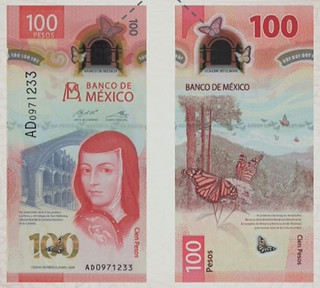 A new 100-peso banknote, the third in a new family of bills, was placed in circulation Thursday by the central bank.
A new 100-peso banknote, the third in a new family of bills, was placed in circulation Thursday by the central bank.
Featuring the likeness of 17th century feminist poet and nun Sister Juana Inés de la Cruz on one side and an image of monarch butterflies in a pine, oak and fir forest on the other, the predominantly red-colored note is made of polymer rather than paper.
"It has a vertical format and unique security elements," Bank of México Governor Alejandro Díaz de León told a press conference.
Among them: embossing perceptible by touch on the Sor (Sister) Juana side, a transparent window similar to those on the existing 20-peso and 50-peso banknotes, a multicolor denomination and fluorescent ink.
Presenting the new note, Díaz described Sor Juana as an "erudite and combative writer who fought to overcome the obstacles that limited women's access to culture."
The new 100-peso note replaces a paper bill featuring the likeness of Nezahualcóyotl, a ruler of the city-state of Texcoco in the 15th century. That note remains legal tender but will be gradually withdrawn from circulation.
The release of the new banknote comes two years after a new 500-peso bill featuring images of former president Benito Juárez and a gray whale entered circulation and one year after a new 200-peso note was introduced.
To read the complete article, see:
Bank of México puts new 100-peso banknote into circulation
(https://mexiconewsdaily.com/news/bank-of-mexico-puts-new-100-peso-banknote-into-circulation/)
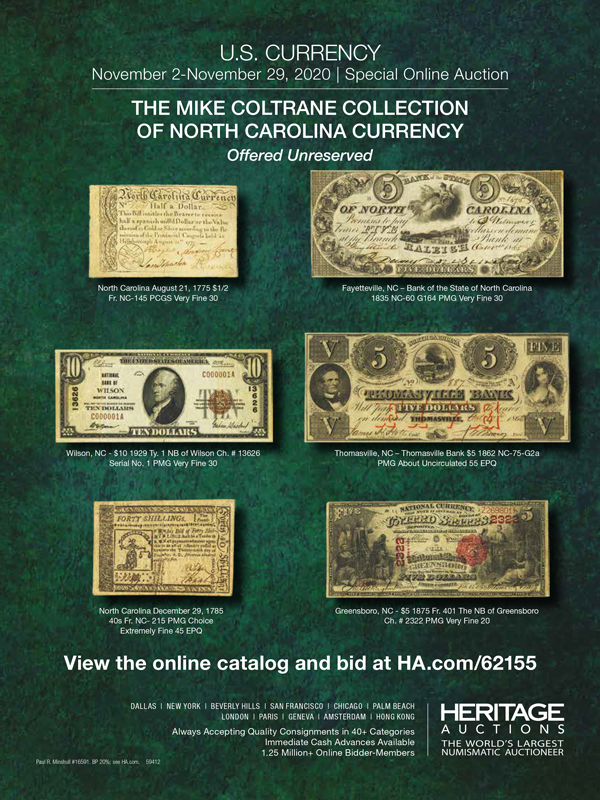
IRAN'S NEW BANKNOTE WITH LIGHT-COLOR ZEROES
Like Zimbabwe and other collapsing economies, Iran is revaluing its currency to lop off embarrassing zeros, starting the transition with printing the doomed zeros in a lighter color. -Editor
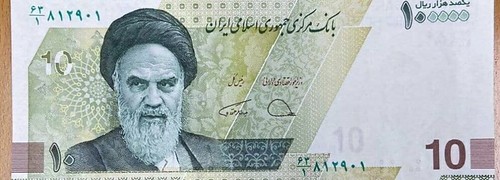
The Central Bank of Iran circulated a new 100,000-rial banknote with four zeroes having a light color signifying the CBI's plan to remove four zeros from the national currency.
According to the state-owned news agency, IRNA, the new banknote has been printed in new dimensions and with improved security features.
The CBI has said it has plans to redenominate the rial by shaving off four zeros and changing the monetary unit from the rial to the popularly used ‘toman'.
The CBI's governor Abdolnasser Hemmati has publicly defended the change. Addressing lawmakers earlier, Hemmati said, "the rial has lost its reason for being and the toman has become the norm."
Proponents of the plan argue that lopping off four zeros is necessary given the diminishing value and prestige of the devalued national currency.
To read the complete article, see:
Iran's New Banknote With 4 Light-Color Zeroes
(https://financialtribune.com/articles/business-and-markets/106102/iran-s-new-banknote-with-4-light-color-zeroes)
Here's another image. -Editor
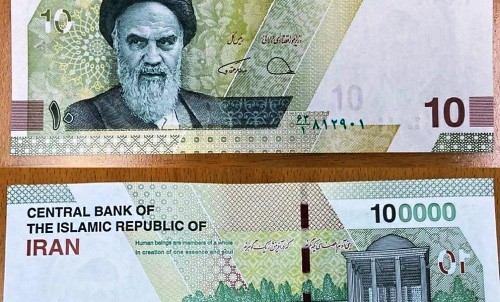
To read the complete article, see:
Iran begins deleting zeros from its currency and a new banknote
(https://search4dinar.wordpress.com/2020/11/12/iran-begins-deleting-zeros-from-its-currency-and-a-new-banknote/)
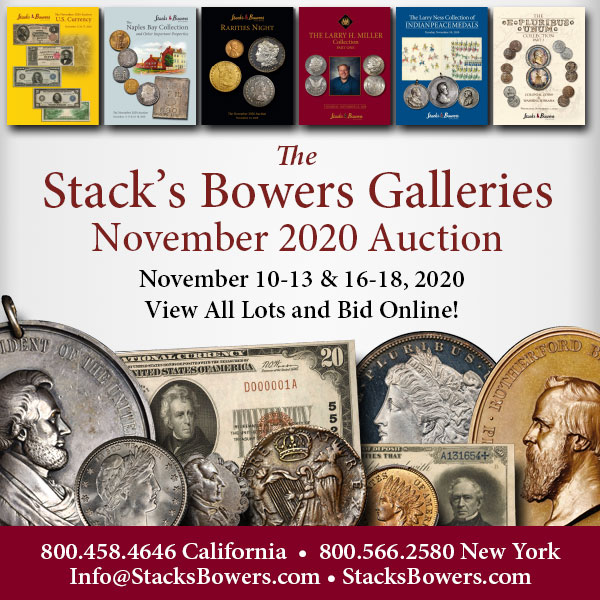
THE EYE OF PROVIDENCE
This BBC article explores the history and meaning of the Eye of Providence, the mysterious symbol adorning U.S. paper money and medals. -Editor
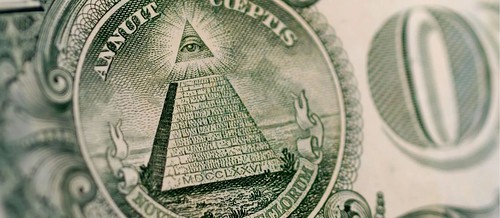
Conspiracy theories thrive on cryptic symbols and covert visual signs. The ‘Eye of Providence' – an eye set within a triangle – is one such symbol, associated with Freemasonry but also linked with the apocryphal Illuminati, a secret group of elite individuals allegedly seeking to control global affairs.
The Eye of Providence is a lightning rod for conspiracy theorists because it is very much hidden in plain sight: not only does it appear on countless churches and Masonic buildings worldwide, it also features on the reverse of the American one-dollar bill as well as the Great Seal of the United States.
In truth, it's an uncanny and frankly odd choice for a US symbol of state. The disembodied eye strongly conveys the sense of a prying authoritarian Big Brother. In combination with the pyramid beneath it, we have emblems suggesting an ancient and esoteric cult. So, what are the origins of the Eye of Providence, why does it fascinate us so much, and why is it frequently connected with the Freemasons and the Illuminati?
Originally the Eye of Providence was a Christian symbol, and the earliest examples of its use can be found in religious art of the Renaissance period to represent God. An early example is Pontormo's 1525 Supper at Emmaus, although the symbol itself was painted on later, perhaps in the 1600s.
Another key source of the icon was in a book of emblems called the Iconologia, published first in 1593. In later editions, the Eye of Providence was included as an attribute of the personification of ‘Divine Providence', ie God's benevolence. As the name of the symbol and its early usage suggest, it was invented as a sign of God's compassionate watchfulness over humanity.
Nobody is certain who originally invented it, but whoever did crafted it out of a set of previously existing religious motifs. The triangle was a long-standing symbol of the Christian Trinity of Father, Son and Holy Spirit; sometimes in previous centuries God was even depicted with a triangular halo. The rays of light that are often shown emanating from the symbol are also a pre-existing sign of God's radiance in Christian iconography. But what are the origins of that eerie disembodied eye? God had been depicted in numerous cryptic ways before, such as by a single hand emerging from a cloud, but not as an eye.
But there is a deeper history to the eye as a symbol to consider – one that takes us back to the earliest known religions. In the third millennium BCE, the Sumerians conveyed the holiness of certain sculptures by abnormally enlarging their eyes to enhance the sensation of dutiful watchfulness. They even held ceremonies in which artists brought the sculptures to life by ‘opening' the figures' eyes.
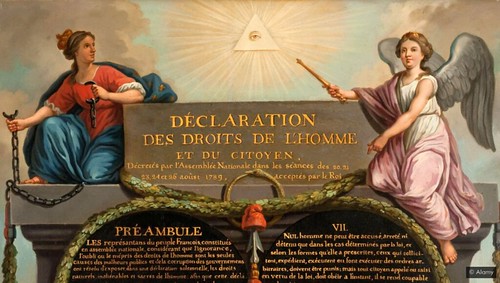
The Eye of Providence appeared in Le Barbier's 1789
The Declaration of the Rights of Man and of the Citizen
In post-revolutionary France, Jean-Jacques-François Le Barbier's 1789 The Declaration of the Rights of Man and of the Citizen featured the text of the radical new declaration with the Eye of Providence at the top. In this case, it has become an instrument of paternalistic reason watching over the newly egalitarian nation.
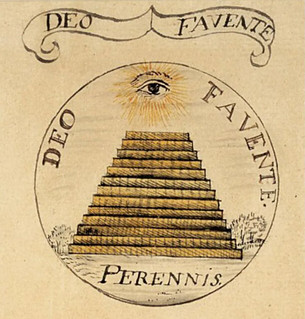 A few years earlier, in 1782 the Great Seal of the United States of America was unveiled. Thomas Jefferson, Benjamin Franklin and John Adams had proposed ideas for the design, but it was Charles Thomson, Secretary of the Continental Congress, who came up with the pyramid and Eye of Providence, among the other elements of the seal, in collaboration with a young lawyer and artist named William Barton. The unfinished pyramid was intended to symbolise "strength and duration", with 13 levels to represent the 13 original states of America. The Eye of Providence – like the other two examples from the same period in Britain and France – was a conventional symbol for God's sympathetic oversight of this fledgling nation. In none of those examples was Freemasonry involved with the choice of symbol.
A few years earlier, in 1782 the Great Seal of the United States of America was unveiled. Thomas Jefferson, Benjamin Franklin and John Adams had proposed ideas for the design, but it was Charles Thomson, Secretary of the Continental Congress, who came up with the pyramid and Eye of Providence, among the other elements of the seal, in collaboration with a young lawyer and artist named William Barton. The unfinished pyramid was intended to symbolise "strength and duration", with 13 levels to represent the 13 original states of America. The Eye of Providence – like the other two examples from the same period in Britain and France – was a conventional symbol for God's sympathetic oversight of this fledgling nation. In none of those examples was Freemasonry involved with the choice of symbol.
To read the complete article, see:
The Eye of Providence: The symbol with a secret meaning?
(https://www.bbc.com/culture/article/20201112-the-eye-of-providence-the-symbol-with-a-secret-meaning)
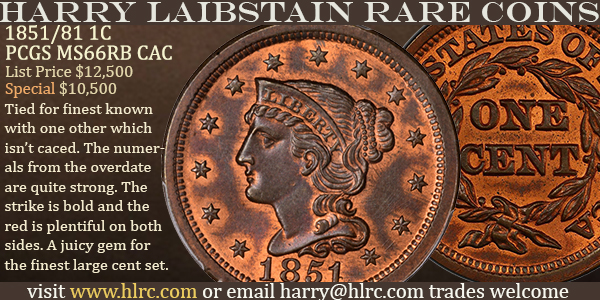
SPENDING THE SPACE FORCE $2 BILL
A reader sent in a link to this video of a YouTuber driving around spending those altered banknote souvenirs we discussed earlier - Trump 2020 Space Force $2 bills. -Editor
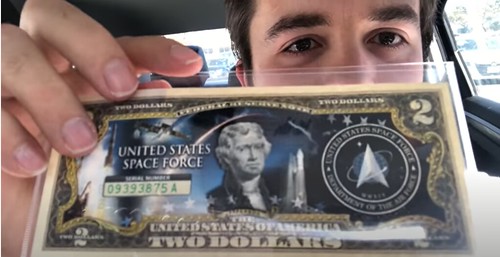

It's a variant of the shtick of Money Artist J.S.G. Boggs - performance art where ordinary people are presented with a decision to accept or reject something that looks like money. He visits drivethrus at Wendy's and McDonalds and actually has success. After all, they are real $2 bills underneath, although I would have expected the two-dollar-bill part to be seen just as fake as the Space Force part. He has less luck in other venues.
For numismatists there are two aspects of note. First, these souvenirs evolve with the times. Post-election, there's now a bill with the slogan "Still My President", creating new varieties for future political memorabilia collectors. At around the 9:45 mark he interviews someone involved in the selling of these items, revealing revenues of $7.5 million on this high-margin merchandise. Divide that by the retail price ($14.95 at National Collectors Mint) gives an estimated issue of about half a million. -Editor
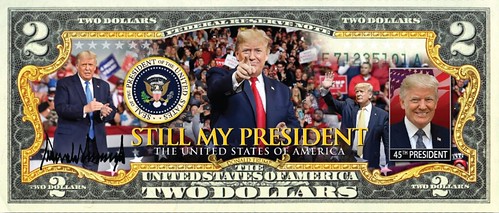
To watch the video, see:
Do Stores Accept the Space Force $2 Bill?
(https://youtu.be/WZh-XiQPkWY)
To read the earlier E-Sylum article, see:
NOTES FROM E-SYLUM READERS: OCTOBER 4, 2020 : Altered Banknote Souvenirs
(https://www.coinbooks.org/v23/esylum_v23n40a09.html)

TRAVANCORE SOUVENIR TABLEWARE MADE FROM COINS
Harold Mernick has created a website of his collection of items made using coins of Travancore. -Editor
 Kingdom of Travancore.
Kingdom of Travancore.
The Kingdom of Travancore was an Indian kingdom from c. 870 until 1949. It was ruled by the Travancore Royal Family. At its zenith, the kingdom covered most of modern-day central and southern Kerala. In 1949 Travancore was incorporated into the newly created state of India.
One Chuckram coins.
The Kingdom of Travancore minted a variety of Gold, Silver and Copper Coins. The most prolific issue was of tiny silver 'Chuckrams'. Molten silver, probably obtained by melting down Indian rupee coins, was dropped into cold water. This caused the silver to fracture into small particles. The powdered silver was weighed out and placed into recesses in a large baked clay slab. This slab had thousands of small round recesses to hold the silver. The slab was then placed into an oven, resulting in the production of precisely weighed silver beads. The beads were then struck between coin dies to produce the one chuckram coins. The dies used were made for the larger two chuckram (Velli Fanam) coin, with the result that most of the coins were struck from different parts of the dies.
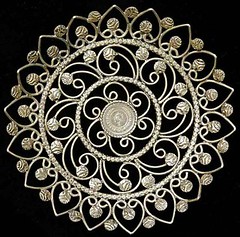
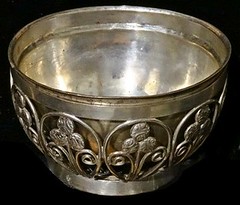
Who were these items made for?.
The dates on the coins go right up to the end of the independant Kindom in 1949. All my examples have been found in Britain. No examples have been identified in the former Travancore area. Given that the items all seem to have travelled from Travancore to Britain, and were not made after 1949, my supposition is that the items were all made in Travancore for sale to British Service personnel, terminating in 1949.
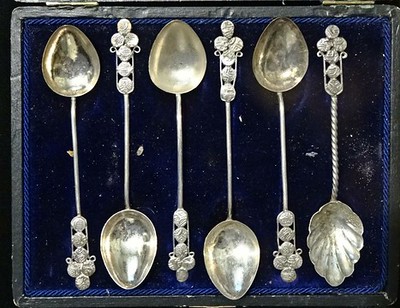
What is known of these items in India.
So far as I can determine - nothing at all is known in India itself. The Travancore area is known for Gold Smithing, but has no history of working silver. The fact that the items are made exclusively from Travancore coins, must surely mean that they were made in Travancore. It must be assumed that these very 'British' seeming items were of little interest to Travancore residents, and were all carried home by the departing British. There seems, now, to be no local memory of them.
To visit the website, see:
Travancore Souvenir Table Ware made from silver coins.
(http://www.mernick.org.uk/cc/Travancore/)

LOOSE CHANGE: NOVEMBER 22, 2020
Here are some additional items in the media this week that may be of interest. -Editor
Todd Martin of the U.S. Mint
On Coin Update Lou Golino published an interview with Todd Martin of the U.S. Mint. -Editor
I recently interviewed Todd Martin, a member of the United States Mint's leadership team serving as the Acting Chief of Corporate Communications, about the forthcoming design changes to the American Silver and Gold Eagle coin programs and current legislation to create a series of quarter dollar and other coin programs starting in 2022. I wanted to clarify some points relating to these programs, including the impetus for the proposed new programs and other issues.
Mr. Martin leads a team of 13 U.S. Mint personnel, who perform wide range of public affairs activities, including media relations, external relations, social media, website management, education outreach, internal communications, videography, photography, event planning, and public affairs support to the U.S. Mint's senior leaders. He has 30 years of experience, which includes positions in the military, private sector, and government.
To read the complete article, see:
Interview with Todd Martin of the United States Mint
(https://news.coinupdate.com/interview-with-todd-martin-of-the-united-states-mint/)
Home Buyer Finds $25K Coin Cache
Richard Miranda and Rick Lank forwarded this story about a home buyer's surprise find. Thanks! Great story. -Editor
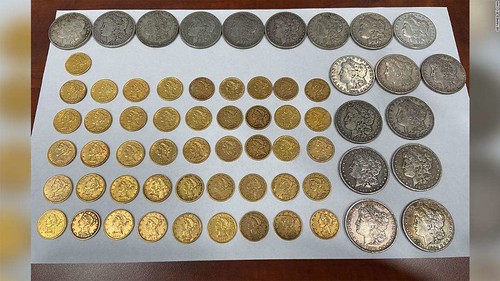
A South Carolina couple found a forgotten treasure while settling into their new home -- dozens of gold and silver coins worth thousands of dollars.
James Munford was checking out the built-in drawers in his closet last month, when he found two cases holding 46 gold Liberty $5 coins and 18 Morgan silver dollars that were made in the 1800s.
He texted pictures of the coins to the home's former owner and made arrangements to return them.
"I was just thinking, you know, they're not mine. They're probably a family heirloom, so I'm gonna go ahead and make sure he gets them back," Munford said.
The home's previous owner, who asked not to be named, estimated that the coins were worth about $25,000.
He said he'd put the containers in the back of his sock drawer a few months ago for safe keeping and didn't see it in his rush to get packed up and moved out of the house. The rest of his coin collection was in his safe.
He didn't realize the coins were missing until the Munfords contacted him and said he never would have known if they had decided to sell the coins and keep the money for themselves.
To read the complete article, see:
New homeowners found coins worth $25,000 in a drawer -- and then gave them back
(https://www.msn.com/en-us/news/good-news/new-homeowners-found-coins-worth-dollar25000-in-a-drawer-and-then-gave-them-back/ar-BB1b8zqw)
Ziggy Catches a Big One
Nick Graver passed along this Ziggy cartoon. Thanks! -Editor
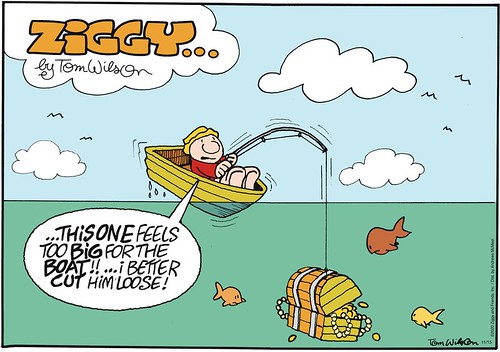
To read the complete article, see:
Ziggy by Tom Wilson & Tom II for November 15, 2020
(https://www.gocomics.com/ziggy/2020/11/15)

STIR-UP THREEPENNY PIECES
David Pickup submitted this article on Stir-up Threepenny Pieces. I hadn't heard that particular term before. -Editor
Stir-up Sunday is the last Sunday before the season of Advent. It gets its name from the beginning of the collect for the day in the Book of Common Prayer, which begins with the words, "Stir up, we beseech thee, O Lord, the wills of thy faithful people". It became associated with the custom of making the Christmas puddings on that day. Traditionally, families gather together in the kitchen of their homes to mix a Christmas pudding on Stir-up Sunday.
Stir up, we beseech thee, O Lord, the wills of thy faithful people; that they, plenteously bringing forth the fruit of good works, may of thee be plenteously rewarded; through Jesus Christ our Lord. Amen.
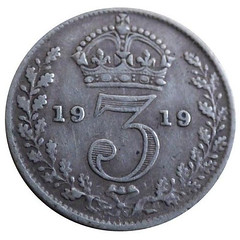 There was also a tradition of adding silver threepence coins, sometimes called
thrupenny bits, in the pudding mixture. This curious custom started in the Middle
Ages and it was thought to be lucky if anyone found them. However if you broke a
tooth on a coin you may not feel fortunate. Perhaps it was a cunning plan by parents
to encourage children to eat slowly.
There was also a tradition of adding silver threepence coins, sometimes called
thrupenny bits, in the pudding mixture. This curious custom started in the Middle
Ages and it was thought to be lucky if anyone found them. However if you broke a
tooth on a coin you may not feel fortunate. Perhaps it was a cunning plan by parents
to encourage children to eat slowly.
On 25th December 1925 the Western Gazette reported that the Royal Mint normally issued more coins at Christmas. In past years silver threepences had been popular but that had declined because they turn a "bilious" (sickly) colour when cooked! Before 1920 coins contained 92.5% silver. Perhaps the colour change related to the reduced bullion content. Brass twelve sided threepence coins were started in 1937, and on 13th October 1937 the Evening Times of Dundee reported a Royal Mint official warning not to put any of new twelve sided threepences in Christmas puddings because possibility of poisoning or "flavoured puddings". I wonder what threepence flavour is like? I am not offering to find out!
The custom has not died out. The Royal Mint and some coin dealers sell silver thrupenny bits. I have never found one. Perhaps a treat for numismatist would be to find a slabbed rare coin in their Christmas pudding.
Here's a related tradition - according to Wikipedia "Vasilopita is a New Year's Day bread or cake in Greece and many other areas in eastern Europe and the Balkans which contains a hidden coin or trinket which gives good luck to the receiver, like the Western European." -Editor
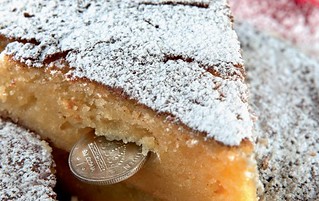 What is a Vasilopita and why is it unique? The answer lies in the direct translation from the Greek, meaning "Basil's Bread" but with a very interesting twist.
What is a Vasilopita and why is it unique? The answer lies in the direct translation from the Greek, meaning "Basil's Bread" but with a very interesting twist.
The Vasilopita is usually celebrated on New Year's Eve, but in many counties, it takes place on Christmas, and the end result is a beautiful family tradition, the Vasilopita it is actually a very flavorful cake rather than just a bread, it has a very interesting legacy, in that a lucky coin is baked right into it, and everyone knows this, anxiously waiting for that moment of who will find the coin in their piece, known to promise good fortune for the rest of the year.
This year, the traditional "Cutting of the Vasilopita" will be as unusual as the upcoming Thanksgiving holiday, where normally, family and friends get together to celebrate their gratitude. In the age of Covid-19 and social distancing, many are understandably afraid, cautious, and bewildered. But one must think back into the history that has endured the survival of this 1,600-year tradition, where people still celebrated despite famine, disease, conflicts, and other difficult struggles, mainly because the human spirit is thankfully strong and unyielding.
According to legend, in the ancient city of Caesarea in 300ad, lived a bishop named Basil, who later became a saint. When his city was under siege by a ruthless tyrant, Basil asked the people to help pay a ransom in order to save their city. The tyrant, humiliated by the total solidarity of the city's townspeople, finally reversed his position without taking the ransom.
Saint Basil was now faced with the responsibility of how to return the valuables to the people. Facing a conclusion that was seemingly impossible for anyone to know what belonged to whom, he tasked the village bakers to make loaves of bread in which were placed their valuables, but the underlying miracle was that everyone received exactly what they had donated.
The Vasilopita tradition, which continues to this day, is celebrated by Eastern Orthodox people around the world, in the United States, Greece, Eastern Europe, Albania, Bosnia, Bulgaria, Croatia, Kosovo, Montenegro, North Macedonia, Romania, Serbia, and Slovenia, where the family cuts the Vasilopita at midnight on the New Year's Eve to bless their house and to bring good luck.
To read the complete article, see:
The Legend of Vasilopita and the Lucky Gold Coin
(https://www.einnews.com/pr_news/531225363/the-legend-of-vasilopita-and-the-lucky-gold-coin)
A recipe for New Years Cake:
New Years Cake (Vasilopita)
(http://www.icookgreek.com/en/recipes/item/new-years-cake-vasilopita)
FEATURED WEB SITE: MR. PEPYS' SMALL CHANGE
This week's Featured Web Site is Mr. Pepys' Small Change.
The Trade Tokens of Samuel Pepys' London – An Introduction
This site is dedicated to all aspects of the paranumismatics of 17th century London, particularly (but not exclusively) that series of privately issued traders' token that circulated in and around the city during the period 1648/9 to 1672. This is a period for which we know a huge amount regarding the detail of everyday life and death in the city from Samuel Pepys' celebrated diaries. Pepys himself had close associations with several of the people and establishments that issued these tokens and will almost certainly have regularly found them amongst the small change in his coat pockets.

https://c17thlondontokens.com/

